![]()
![]()
![]()
Use LEFT and RIGHT arrow keys to navigate between flashcards;
Use UP and DOWN arrow keys to flip the card;
H to show hint;
A reads text to speech;
28 Cards in this Set
- Front
- Back
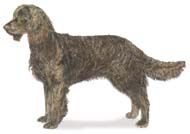
|
American Water Spaniel Breed Standard
General Appearance The American Water Spaniel was developed in the United States as an all-around hunting dog, bred to retrieve from skiff or canoes and work ground with relative ease. The American Water Spaniel is an active muscular dog, medium in size with a marcel to curly coat. Emphasis is placed on proper size and a symmetrical relationship of parts, texture of coat and color. Size, Proportion, Substance 15 to 18 inches for either sex. Males weighing 30-45 lbs. Females weighing 25-40 lbs. Females tend to be slightly smaller than the males. There is no preference for size within the given range of either sex providing correct proportion, good substance and balance is maintained. Proportion--is slightly longer than tall, not too square or compact. However, exact proportion is not as important as the dog being well-balanced and sound, capable of performing the breed's intended function. Substance --a solidly built and well-muscled dog full of strength and quality. The breed has as much substance and bone as necessary to carry the muscular structure but not so much as to appear clumsy. Head The head must be in proportion to the overall dog. Moderate in length. Expression is alert, self-confident, attractive and intelligent. Medium size eyes set well apart, while slightly rounded, should not appear protruding or bulging. Lids tight, not drooping. Eye color can range from a light yellowish brown to brown, hazel or of dark tone to harmonize with coat. Disqualify yellow eyes. Yellow eyes are a bright color like that of lemon, not to be confused with the light yellowish brown. Ears set slightly above the eye line but not too high on the head, lobular, long and wide with leather extending to nose. Skull rather broad and full, stop moderately defined, but not too pronounced. Muzzle moderate in length, square with good depth. No inclination to snipiness, The lips are clean and tight without excess skin or flews. Nose dark in color, black or dark brown. The nose sufficiently wide and with well-developed nostrils to insure good scenting power. Bite either scissor or level. Neck, Topline, Body Neck round and of medium length, strong and muscular, free of throatiness, set to carry head with dignity, but arch not accentuated. Topline level or slight, straight slope from withers. Body well-developed, sturdily constructed but not too compactly coupled. Well-developed brisket extending to elbow neither too broad nor too narrow. The ribs well-sprung, but not so well-sprung that they interfere with the movement of the front assembly. The loins strong, but not having a tucked-up look. Tail is moderate in length, curved in a rocker fashion, can be carried either slightly below or above the level of the back. The tail is tapered, lively and covered with hair with moderate feathering. Forequarters Shoulders sloping, clean and muscular. Legs medium in length, straight and well-boned but not so short as to handicap for field work or so heavy as to appear clumsy. Pasterns strong with no suggestion of weakness. Toes closely grouped, webbed and well-padded. Size of feet to harmonize with size of dog. Front dewclaws are permissible. Hindquarters Well-developed hips and thighs with the whole rear assembly showing strength and drive. The hock joint slightly rounded, should not be small and sharp in contour, moderately angulated. Legs from hock joint to foot pad moderate in length, strong and straight with good bone structure. Hocks parallel. Coat Coat can range from marcel (uniform waves) to closely curled. The amount of waves or curls can vary from one area to another on the dog. It is important to have undercoat to provide sufficient density to be of protection against weather, water or punishing cover, yet not too coarse or too soft. The throat, neck and rear of the dog well-covered with hair. The ear well-covered with hair on both sides with ear canal evident upon inspection. Forehead covered with short smooth hair and without topknot. Tail covered with hair to tip with moderate feathering. Legs have moderate feathering with waves or curls to harmonize with coat of dog. Coat may be trimmed to present a wellgroomed appearance; the ears may be shaved; but neither is required. Color Color either solid liver, brown or dark chocolate. A little white on toes and chest permissible. Gait The American Water Spaniel moves with well-balanced reach and drive. Watching a dog move toward one, there should be no signs of elbows being out. Upon viewing the dog from the rear, one should get the impression that the hind legs, which should be well-muscled and not cowhocked, move as nearly parallel as possible, with hocks doing their full share of work and flexing well, thus giving the appearance of power and strength. Temperament Demeanor indicates intelligence, eagerness to please and friendly. Great energy and eagerness for the hunt yet controllable in the field. Disqualification Yellow eyes. Approved March 13, 1990 Effective May 1, 1990 |
|
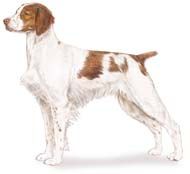
|
Brittany Breed Standard
Sporting Group General Appearance A compact, closely knit dog of medium size, a leggy dog having the appearance, as well as the agility, of a great ground coverer. Strong, vigorous, energetic and quick of movement. Ruggedness, without clumsiness, is a characteristic of the breed. He can be tailless or has a tail docked to approximately four inches. Size, Proportion, Substance Height--17½ to 20½ inches, measured from the ground to the highest point of the shoulders. Any Brittany measuring under 17½ inches or over 20½ inches shall be disqualified from dog show competition. Weight--Should weigh between 30 and 40 pounds. Proportion--So leggy is he that his height at the shoulders is the same as the length of his body. Body Length--Approximately the same as the height when measured at the shoulders. Body length is measured from the point of the forecast to the rear of the rump. A long body should be heavily penalized. Substance--Not too light in bone, yet never heavy-boned and cumbersome. Head Expression--Alert and eager, but with the soft expression of a bird dog. Eyes--Well set in head. Well protected from briars by a heavy, expressive eyebrow. A prominent full or popeye should be penalized. It is a serious fault in a dog that must face briars. Skull well chiseled under the eyes, so that the lower lid is not pulled back to form a pocket or haw that would catch seeds, dirt and weed dust. Preference should be for the darker colored eyes, though lighter shades of amber should not be penalized. Light and mean-looking eyes should be heavily penalized. Ears--Set high, above the level of the eyes. Short and triangular, rather than pendulous, reaching about half the length of the muzzle. Should lie flat and close to the head, with dense, but relatively short hair, and with little fringe. Skull--Medium length, rounded, very slightly wedge-shaped, but evenly made. Width, not quite as wide as the length and never so broad as to appear coarse, or so narrow as to appear racy. Well defined, but gently sloping stop. Median line rather indistinct. The occiput only apparent to the touch. Lateral walls well rounded. The Brittany should never be "apple-headed" and he should never have an indented stop. Muzzle--Medium length, about two thirds the length of the skull, measuring the muzzle from the tip to the stop, and the skull from the occiput to the stop. Muzzle should taper gradually in both horizontal and vertical dimensions as it approaches the nostrils. Neither a Roman nose nor a dish-face is desirable. Never broad, heavy or snippy. Nose--Nostrils well open to permit deep breathing of air and adequate scenting. Tight nostrils should be penalized. Never shiny. Color: fawn, tan, shades of brown or deep pink. A black nose is a disqualification. A two-tone or butterfly nose should be penalized. Lips--Tight, the upper lip overlapping the lower jaw just to cover the lower lip. Lips dry, so that feathers will not stick. Drooling to be heavily penalized. Flews to be penalized. Bite--A true scissors bite. Overshot or undershot jaw to be heavily penalized. Neck, Topline, Body Neck--Medium length. Free from throatiness, though not a serious fault unless accompanied by dewlaps, strong without giving the impression of being over muscled. Well set into sloping shoulders. Never concave or ewe-necked. Topline--Slight slope from the highest point of the shoulders to the root of the tail. Chest--Deep, reaching the level of the elbow. Neither so wide nor so rounded as to disturb the placement of the shoulders and elbows. Ribs well sprung. Adequate heart room provided by depth as well as width. Narrow or slab-sided chests are a fault. Back--Short and straight. Never hollow, saddle, sway or roach backed. Slight drop from the hips to the root of the tail. Flanks--Rounded. Fairly full. Not extremely tucked up, or flabby and falling. Loins short and strong. Distance from last rib to upper thigh short, about three to four finger widths. Narrow and weak loins are a fault. In motion, the loin should not sway sideways, giving a zig-zag motion to the back, wasting energy. Tail--Tailless to approximately four inches, natural or docked. The tail not to be so long as to affect the overall balance of the dog. Set on high, actually an extension of the spine at about the same level. Any tail substantially more than four inches shall be severely penalized. Forequarters Shoulders--Shoulder blades should not protrude too much, not too wide apart, with perhaps two thumbs' width between. Sloping and muscular. Blade and upper arm should form nearly a ninety degree angle. Straight shoulders are a fault. At the shoulders, the Brittany is slightly higher than at the rump. Front Legs--Viewed from the front, perpendicular, but not set too wide. Elbows and feet turning neither in nor out. Pasterns slightly sloped. Down in pasterns is a serious fault. Leg bones clean, graceful, but not too fine. Extremely heavy bone is as much a fault as spindly legs. One must look for substance and suppleness. Height at elbows should approximately equal distance from elbow to withers. Feet--Should be strong, proportionately smaller than the spaniels', with close fitting, well arched toes and thick pads. The Brittany is "not up on his toes." Toes not heavily feathered. Flat feet, splayed feet, paper feet, etc., are to be heavily penalized. An ideal foot is halfway between the hare and the cat foot. Dewclaws may be removed. Hindquarter Broad strong and muscular, with powerful thighs and well bent stifles, giving the angulation necessary for powerful drive. Hind Legs--Stifles well bent. The stifle should not be so angulated as to place the hock joint far out behind the dog. A Brittany should not be condemned for straight stifle until the judge has checked the dog in motion from the side. The stifle joint should not turn out making a cowhock. Thighs well feathered but not profusely, halfway to the hock. Hocks, that is, the back pasterns, should be moderately short, pointing neither in nor out, perpendicular when viewed from the side. They should be firm when shaken by the judge. Feet Same as front feet. Coat Dense, flat or wavy, never curly. Texture neither wiry nor silky. Ears should carry little fringe. The front and hind legs should have some feathering, but too little is definitely preferable to too much. Dogs with long or profuse feathering or furnishings shall be so severely penalized as to effectively eliminate them from competition. Skin--Fine and fairly loose. A loose skin rolls with briars and sticks, thus diminishing punctures or tearing. A skin so loose as to form pouches is undesirable. Color Orange and white or liver and white in either clear or roan patterns. Some ticking is desirable. The orange or liver is found in the standard parti-color or piebald patterns. Washed out colors are not desirable. Tri-colors are allowed but not preferred. A tri-color is a liver and white dog with classic orange markings on eyebrows, muzzle and cheeks, inside the ears and under the tail, freckles on the lower legs are orange. Anything exceeding the limits of these markings shall be severely penalized. Black is a disqualification. Gait When at a trot the Brittany's hind foot should step into or beyond the print left by the front foot. Clean movement, coming and going, is very important, but most important is side gait, which is smooth, efficient and ground covering. Temperament A happy, alert dog, neither mean nor shy. Disqualifications Any Brittany measuring under 17½ inches or over 20½ inches A black nose Black in the coat Approved April 10, 1990 Effective May 31, 1990 |
|
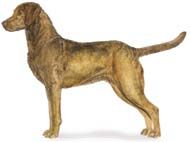
|
Chesapeake Bay Retriever Breed Standard
Sporting Group; AKC recognized in 1878. Average size: 55 to 80 pounds and 21 to 26 inches tall at the shoulder. Water dog; Retriever. |
|
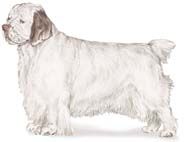
|
Clumber Spaniel Breed Standard
Sporting Group General Appearance The Clumber Spaniel is a long, low, substantial dog. His heavy brow, deep chest, straight forelegs, powerful hindquarters, massive bone and good feet all give him the power and endurance to move through dense underbrush in pursuit of game. His white coat enables him to be seen by the hunter as he works within gun range. His stature is dignified, his expression pensive, but at the same time he shows great enthusiasm for work and play. Size, Proportion, Substance The Clumber is rectangular in shape possessing massive bone structure and has the appearance of great power. The ideal height for dogs is 18 to 20 inches at the withers and for bitches is 17 to 19 inches at the withers. The ideal length to height is 11 to 9 measured from the withers to the base of the tail and from the floor to the withers. Dogs weigh between 70 and 85 pounds and bitches weigh between 55 and 70 pounds. Head The head is massive with a marked stop and heavy brow. The top skull is flat with a pronounced occiput. A slight furrow runs between the eyes and up through the center of the skull. The muzzle is broad and deep to facilitate retrieving many species of game. The nose is large, square and colored shades of brown, which include beige, rose and cherry. The flews of the upper jaw are strongly developed and overlap the lower jaw to give a square look when viewed from the side. A scissors bite is preferred. The eyes are dark amber in color, large, soft in expression, and deep set in either a diamond shaped rim or a rim with a "V" on the bottom and a curve on the top. Some haw may show but excessive haw is undesirable. Prominent or round shaped eyes are to be penalized. Excessive tearing or evidence of entropion or ectropion is to be penalized. Ears are broad on top with thick ear leather. The ears are triangular in shape with a rounded lower edge, set low and attached to the skull at approximately eye level. Neck, Topline, Body The Clumber should have a long neck with some slackness of throat or presence of dewlap not to be faulted. The neck is strong and muscular, fitting into a well laid back shoulder. The back is straight, firm, long and level. The brisket is deep and the ribs well sprung. The chest is deep and wide. The loin arches slightly. The tail is well feathered and set on just below the line of back; its trimming minimal, serving to tidy the feathering to allow for a natural appearance and outline. The tail is normally carried level with the topline or slightly elevated, never down between the rear legs. The tail may be docked or left natural, both being of equal value. If docked, the tail's length should be in keeping with the overall proportion of the adult dog. If natural, the tailbone should extend to the point of hock, but should not extend to the ground. Forequarters The Clumber shoulder is well laid back. The upper arm is of sufficient length to place the elbow under the highest point of the shoulder. The forelegs are short, straight and heavy in bone, with elbows held close to the body. Pasterns are strong and only slightly sloped. The front feet are large, compact and have thick pads that act as shock absorbers. Removal of dewclaws is optional. Hindquarters The thighs are heavily muscled and, when viewed from behind, the rear is round and broad. The stifle shows good functional angulation, and hock to heel is short and perpendicular to the ground. Lack of angulation is objectionable. The rear feet are not as large or as round as on the front feet but compact, with thick pads and are of substantial size. Coat The body coat is dense, straight and flat. It is of good weather resistant texture, which is soft to the touch, not harsh. Ears are slightly feathered with straight hair. Feathering on the legs and belly is moderate. The Clumber has a good neck frill and on no condition should his throat be shaved. Evidence of shaving is to be penalized. The hair on the feet should be trimmed neatly to show their natural outline and for utility in the field. The rear legs may be trimmed up to the point of the hock. Tail feathering may be tidied. Trimming of whiskers is optional. Color and Markings The Clumber is primarily a white dog with lemon color or orange color markings. Markings are frequently seen on one or both ears and the face. Facial markings include color around one or both eyes, freckling on the muzzle and a spot on top of the head. A head with lemon/orange markings and an all-white head are of equal value. Freckles on the legs and/or a spot near the root of the tail are also frequently seen and acceptable. The body should have as few markings as possible. Gait The Clumber moves easily and freely with good reach in front and strong drive from behind, neither crossing over nor elbowing out. The hocks drive in a straight line without rocking or twisting. Because of his wide body and short legs he tends to roll slightly. The proper Clumber roll occurs when the dog, with the correct proportion, reaches forward with the rear leg toward the centerline of travel and rotates the hip downward while the back remains level and straight. The gait is comfortable and can be maintained at a steady trot for a day of work in the field without exhaustion. Temperament The Clumber Spaniel is a gentle, loyal and affectionate dog. He possesses an intrinsic desire to please. An intelligent and independent thinker, he displays determination and a strong sense of purpose while at work. A dog of dignity, the Clumber Spaniel may sometimes seem aloof with people unknown to him, but in time he will display his playful and loving nature. The Clumber Spaniel should never be hostile or aggressive; neither is acceptable and should not be condoned. Approved: January 8, 2001 Effective: March 28, 2001 |
|

|
Cocker Spaniel Breed Standard
Sporting Group Sporting Group; AKC recognized in 1878. Average size: from 13 ½ inches to 15 ½ inches at the shoulder. Family pet, hunting dog. |
|
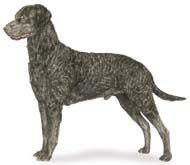
|
Curly-Coated Retriever Breed Standard
Sporting Group General Appearance This smartly upstanding, multi-purpose hunting retriever is recognized by most canine historians as one of the oldest of the retrieving breeds. Developed in England, the Curly was long a favorite of English gamekeepers. Prized for innate field ability, courage and indomitable perseverance, a correctly built and tempered Curly will work as long as there is work to be done, retrieving both fur and feather in the heaviest of cover and the iciest of waters. To work all day a Curly must be balanced and sound, strong and robust, and quick and agile. Outline, carriage and attitude all combine for a grace and elegance somewhat uncommon among the other retriever breeds, providing the unique, upstanding quality desired in the breed. In outline, the Curly is moderately angulated front and rear and, when comparing height to length, gives the impression of being higher on leg than the other retriever breeds. In carriage, the Curly is an erect, alert, self-confident dog. In motion, all parts blend into a smooth, powerful, harmonious symmetry. The coat, a hallmark of the breed, is of great importance for all curlies, whether companion, hunting or show dogs. The perfect coat is a dense mass of small, tight, distinct, crisp curls. The Curly is wickedly smart and highly trainable and, as such, is cherished as much for his role as loyal companion at home as he is in the field. Size, Proportion, Substance Ideal height at withers: dogs, 25 to 27 inches; bitches, 23 to 25 inches. A clearly superior Curly falling outside of this range should not be penalized because of size. The body proportions are slightly off square, meaning that the dog is slightly longer from prosternum to buttocks as he is from withers to ground. The Curly is both sturdy and elegant. The degree of substance is sufficient to ensure strength and endurance without sacrificing grace. Bone and substance are neither spindly nor massive and should be in proportion with weight and height and balanced throughout. Head The head is a longer-than-wide wedge, readily distinguishable from that of all other retriever breeds, and of a size in balance with the body. Length of foreface is equal, or nearly equal, to length of backskull and, when viewed in profile, the planes are parallel. The stop is shallow and sloping. At the point of joining, the width of foreface may be slightly less than the width of the backskull but blending of the two should be smooth. The head has a nearly straight, continuous taper to the nose and is clean cut, not coarse, blocky or cheeky. Expression--Intelligent and alert. Eyes--Almond-shaped, rather large but not too prominent. Black or brown in black dogs and brown or amber in liver dogs. Harsh yellow eyes and loose haws are undesirable. Ears-- Rather small, set on a line slightly above the corner of the eye, and lying close to the head. Backskull--Flat or nearly flat. Foreface--Muzzle is wedge-shaped with no hint of snipiness. The taper ends mildly, neither acutely pointed nor bluntly squared-off but rather slightly rounding at the bottom. Mouth is level and never wry. Jaws are long and strong. A scissors bite is preferred. Teeth set straight and even. The lips are tight and clean, not pendulous. The nose is fully pigmented; black on black dogs, brown on liver dogs. Nostrils are large. Neck, Topline, Body Neck--Strong and slightly arched, of medium length, free from throatiness and flowing freely into moderately laid-back shoulders. Backline--The back, that portion of the body from the rear point of the withers to the beginning of the loin, is strong and level. The loin, that part of the body extending from the end of the rib cage to the start of the pelvis, is short and muscular. The croup, that portion of the body from the start of the pelvis to the tail set-on, is only slightly sloping. Body-- Chest is decidedly deep and not too wide, oval in cross-section, with brisket reaching elbow. While the impression of the chest should be of depth not width, the chest is not pinched or narrow. The ribs are well-sprung, neither barrel-shaped nor slab-sided, and extend well back into a deep, powerful loin with a moderate tuck-up of flank. Tail--Carried straight or fairly straight, never docked, and reaching approximately to the hock. Never curled over the back and should not be kinked or crooked. Covered with curls and, if trimmed, tapering toward the point. Forequarters Shoulder blades are very long, well covered with muscle, and are moderately laid back at about a 55 degree angle. The width between shoulder blades is adequate to allow enough flexibility to easily retrieve game. Upper arm bones are about equal in length with shoulder blades and laid back at approximately the same angle as the blades, meaning the forelegs are set under the withers. The equal length of shoulder blade and upper arm bone and the balanced angulation between the two allows for good extension of the front legs. The forelegs are straight with strong, true pasterns. Feet are round and compact, with well-arched toes and thick pads. Front dewclaws are generally removed. Hindquarters Strong and in balance with front angulation. Thighs are powerful with muscling carrying well down into the second thigh. Stifle is of moderate bend. The hocks are strong and true, turning neither in nor out, with hock joint well let down. Rear dewclaws are generally removed. Coat The coat is a distinguishing characteristic and quite different from that of any other breed. The body coat is a thick mass of small, tight, crisp curls, lying close to the skin, resilient, water resistant, and of sufficient density to provide protection against weather, water and punishing cover. Curls also extend up the entire neck to the occiput, down the thigh and back leg to at least the hock, and over the entire tail. Elsewhere, the coat is short, smooth and straight, including on the forehead, face, front of forelegs, and feet. A patch of uncurled hair behind the withers or bald patches anywhere on the body, including bald strips down the back of the legs or a triangular bald patch on the throat, should be severely penalized. A looser, more open curl is acceptable on the ears. Sparse, silky, fuzzy or very harsh, dry or brittle hair is a fault. Trimming--Feathering may be trimmed from the ears, belly, backs of forelegs, thighs, pasterns, hocks, and feet. On the tail, feathering should be removed. Short trimming of the coat on the ear is permitted but shearing of the body coat is undesirable. Color Black or liver. Either color is correct. A prominent white patch is undesirable but a few white hairs are allowable in an otherwise good dog. Gait The dual function of the Curly as both waterfowl retriever and upland game hunter demands a dog who moves with strength and power yet is quick and agile. The ground-covering stride is a well-coordinated melding of grace and power, neither mincing nor lumbering. The seemingly effortless trot is efficient and balanced front to rear. When viewed from the side, the reach in front and rear is free-flowing, not stilted or hackneyed. When viewed from the front or rear, movement is true: the front legs turn neither in nor out and the rear legs do not cross. Well-developed, muscular thighs and strong hocks do their full share of work, contributing to rear thrust and drive. The extension in front is strong and smooth and in balance with rear action. Balance in structure translates to balance in movement and is of great importance to ensure soundness and endurance; extremes of angulation and gait are not desirable. Temperament Self-confident, steadfast and proud, this active, intelligent dog is a charming and gentle family companion and a determined, durable hunter. The Curly is alert, biddable and responsive to family and friends, whether at home or in the field. Of independent nature and discerning intelligence, a Curly sometimes appears aloof or self-willed, and, as such, is often less demonstrative, particularly toward strangers, than the other retriever breeds. The Curly’s independence and poise should not be confused with shyness or a lack of willingness to please. In the show ring, a correctly-tempered Curly will steadily stand his ground, submit easily to examination, and might or might not wag his tail when doing so. In the field, the Curly is eager, persistent and inherently courageous. At home, he is calm and affectionate. Shyness is a fault and any dog who shies away from show ring examination should be penalized. Minor allowances can be made for puppies who misbehave in the show ring due to overexuberance or lack of training or experience. Approved October 12, 1993 Effective November 30, 1993 |
|
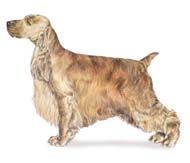
|
English Cocker Spaniel Breed Standard
Sporting Group General Appearance The English Cocker Spaniel is an active, merry sporting dog, standing well up at the withers and compactly built. He is alive with energy; his gait is powerful and frictionless, capable both of covering ground effortlessly and penetrating dense cover to flush and retrieve game. His enthusiasm in the field and the incessant action of his tail while at work indicate how much he enjoys the hunting for which he was bred. His head is especially characteristic. He is, above all, a dog of balance, both standing and moving, without exaggeration in any part, the whole worth more than the sum of its parts. Size, Proportion, Substance Size-Height at withers: males 16 to 17 inches; females 15 to 16 inches. Deviations to be penalized. The most desirable weights: males, 28 to 34 pounds; females, 26 to 32 pounds. Proper conformation and substance should be considered more important than weight alone. Proportion--Compactly built and short-coupled, with height at withers slightly greater than the distance from withers to set-on of tail. Substance--The English Cocker is a solidly built dog with as much bone and substance as is possible without becoming cloddy or coarse. Head General appearance: strong, yet free from coarseness, softly contoured, without sharp angles. Taken as a whole, the parts combine to produce the expression distinctive of the breed. Expression--Soft, melting, yet dignified, alert, and intelligent. Eyes--The eyes are essential to the desired expression. They are medium in size, full and slightly oval; set wide apart; lids tight. Haws are inconspicuous; may be pigmented or unpigmented. Eye color dark brown, except in livers and liver parti-colors where hazel is permitted, but the darker the hazel the better. Ears--Set low, lying close to the head; leather fine, extending to the nose, well covered with long, silky, straight or slightly wavy hair. Skull--Arched and slightly flattened when seen both from the side and from the front. Viewed in profile, the brow appears not appreciably higher than the back-skull. Viewed from above, the sides of the skull are in planes roughly parallel to those of the muzzle. Stop definite, but moderate, and slightly grooved. Muzzle--Equal in length to skull; well cushioned; only as much narrower than the skull as is consistent with a full eye placement; cleanly chiseled under the eyes. Jaws strong, capable of carrying game. Nostrils wide for proper development of scenting ability; color black, except in livers and parti-colors of that shade where they will be brown; reds and parti-colors of that shade may be brown, but black is preferred. Lips square, but not pendulous or showing prominent flews. Bite--Scissors. A level bite is not preferred. Overshot or undershot to be severely penalized. Neck, Topline and Body Neck--Graceful and muscular, arched toward the head and blending cleanly, without throatiness, into sloping shoulders; moderate in length and in balance with the length and height of the dog. Topline--The line of the neck blends into the shoulder and backline in a smooth curve. The backline slopes very slightly toward a gently rounded croup, and is free from sagging or rumpiness. Body--Compact and well-knit, giving the impression of strength without heaviness. Chest deep; not so wide as to interfere with action of forelegs, nor so narrow as to allow the front to appear narrow or pinched. Forechest well developed, prosternum projecting moderately beyond shoulder points. Brisket reaches to the elbow and slopes gradually to a moderate tuck-up. Ribs well sprung and springing gradually to mid-body, tapering to back ribs which are of good depth and extend well back. Back short and strong. Loin short, broad and very slightly arched, but not enough to affect the topline appreciably. Croup gently rounded, without any tendency to fall away sharply. Tail--Docked. Set on to conform to croup. Ideally, the tail is carried horizontally and is in constant motion while the dog is in action. Under excitement, the dog may carry his tail somewhat higher, but not cocked up. Forequarters The English Cocker is moderately angulated. Shoulders are sloping, the blade flat and smoothly fitting. Shoulder blade and upper arm are approximately equal in length. Upper arm set well back, joining the shoulder with sufficient angulation to place the elbow beneath the highest point of the shoulder blade when the dog is standing naturally. Forelegs--Straight, with bone nearly uniform in size from elbow to heel; elbows set close to the body; pasterns nearly straight, with some flexibility. Feet-- Proportionate in size to the legs, firm, round and catlike; toes arched and tight; pads thick. Hindquarters Angulation moderate and, most importantly, in balance with that of the forequarters. Hips relatively broad and well rounded. Upper thighs broad, thick and muscular, providing plenty of propelling power. Second thighs well muscled and approximately equal in length to the upper. Stifle strong and well bent. Hock to pad short. Feet as in front. Coat On head, short and fine; of medium length on body; flat or slightly wavy; silky in texture. The English Cocker is well-feathered, but not so profusely as to interfere with field work. Trimming is permitted to remove overabundant hair and to enhance the dog’s true lines. It should be done so as to appear as natural as possible. Color Various. Parti-colors are either clearly marked, ticked or roaned, the white appearing in combination with black, liver or shades of red. In parti-colors it is preferable that solid markings be broken on the body and more or less evenly distributed; absence of body markings is acceptable. Solid colors are black, liver or shades of red. White feet on a solid are undesirable; a little white on throat is acceptable; but in neither case do these white markings make the dog a parti-color. Tan markings, clearly defined and of rich shade, may appear in conjunction with black, livers and parti-color combinations of those colors. Black and tans and liver and tans are considered solid colors. Gait The English Cocker is capable of hunting in dense cover and upland terrain. His gait is accordingly characterized more by drive and the appearance of power than by great speed. He covers ground effortlessly and with extension both in front and in rear, appropriate to his angulation. In the ring, he carries his head proudly and is able to keep much the same topline while in action as when standing for examination. Going and coming, he moves in a straight line without crabbing or rolling, and with width between both front and rear legs appropriate to his build and gait. Temperament The English Cocker is merry and affectionate, of equable disposition, neither sluggish nor hyperactive, a willing worker and a faithful and engaging companion. Approved October 11, 1988 Effective November 30, 1988 |
|
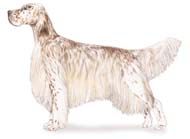
|
English Setter Breed Standard
Sporting Group General Appearance An elegant, substantial and symmetrical gun dog suggesting the ideal blend of strength, stamina, grace, and style. Flat-coated with feathering of good length. Gaiting freely and smoothly with long forward reach, strong rear drive and firm topline. Males decidedly masculine without coarseness. Females decidedly feminine without over-refinement. Overall appearance, balance, gait, and purpose to be given more emphasis than any component part. Above all, extremes of anything distort type and must be faulted. Head Size and proportion in harmony with body. Long and lean with a well defined stop. When viewed from the side, head planes (top of muzzle, top of skull and bottom of lower jaw) are parallel. Skull--oval when viewed from above, of medium width, without coarseness, and only slightly wider at the earset than at the brow. Moderately defined occipital protuberance. Length of skull from occiput to stop equal in length of muzzle. Muzzle-- long and square when viewed from the side, of good depth with flews squared and fairly pendant. Width in harmony with width of skull and equal at nose and stop. Level from eyes to tip of nose. Nose--black or dark brown, fully pigmented. Nostrils wide apart and large. Foreface--skeletal structure under the eyes well chiseled with no suggestion of fullness. Cheeks present a smooth and clean-cut appearance. Teeth--close scissors bite preferred. Even bite acceptable. Eyes--dark brown, the darker the better. Bright, and spaced to give a mild and intelligent expression. Nearly round, fairly large, neither deepset nor protruding. Eyelid rims dark and fully pigmented. Lids fit tightly so that haw is not exposed. Ears--set well back and low, even with or below eye level. When relaxed carried close to the head. Of moderate length, slightly rounded at the ends, moderately thin leather, and covered with silky hair. Neck and Body Neck--long and graceful, muscular and lean. Arched at the crest and cleancut where it joins the head at the base of the skull. Larger and more muscular toward the shoulders, with the base of the neck flowing smoothly into the shoulders. Not too throaty. Topline--in motion or standing appears level or sloping slightly downward without sway or drop from withers to tail forming a graceful outline of medium length. Forechest--well developed, point of sternum projecting slightly in front of point of shoulder/upper arm joint. Chest--deep, but not so wide or round as to interfere with the action of the forelegs. Brisket deep enough to reach the level of the elbow. Ribs--long, springing gradually to the middle of the body, then tapering as they approach the end of the chest cavity. Back--straight and strong at its junction with loin. Loin--strong, moderate in length, slightly arched. Tuck up moderate. Hips--croup nearly flat. Hip bones wide apart, hips rounded and blending smoothly into hind legs. Tail--a smooth continuation of the topline. Tapering to a fine point with only sufficient length to reach the hock joint or slightly less. Carried straight and level with the back. Feathering straight and silky, hanging loosely in a fringe. Forequarters Shoulder--shoulder blade well laid back. Upper arm equal in length to and forming a nearly right angle with the shoulder blade. Shoulders fairly close together at the tips. Shoulder blades lie flat and meld smoothly with contours of body. Forelegs-- from front or side, forelegs straight and parallel. Elbows have no tendency to turn in or out when standing or gaiting. Arm flat and muscular. Bone substantial but not coarse and muscles hard and devoid of flabbiness. Pasterns--short, strong and nearly round with the slope deviating very slightly forward from the perpendicular. Feet--face directly forward. Toes closely set, strong and well arched. Pads well developed and tough. Dewclaws may be removed. Hindquarters Wide, muscular thighs and well developed lower thighs. Pelvis equal in length to and forming a nearly right angle with upper thigh. In balance with forequarter assembly. Stifle well bent and strong. Lower thigh only slightly longer than upper thigh. Hock joint well bent and strong. Rear pastern short, strong, nearly round and perpendicular to the ground. Hind legs, when seen from the rear, straight and parallel to each other. Hock joints have no tendency to turn in or out when standing or gaiting. Coat Flat without curl or wooliness. Feathering on ears, chest, abdomen, underside of thighs, back of all legs and on the tail of good length but not so excessive as to hide true lines and movementor to affect the dog's appearance or function as a sporting dog. Markings and Color Markings--white ground color with intermingling of darker hairs resulting in belton markings varying in degree from clear distinct flecking to roan shading, but flecked all over preferred. Head and ear patches acceptable, heavy patches of color on the body undesirable. Color--orange belton, blue belton (white with black markings), tricolor (blue belton with tan on muzzle, over the eyes and on the legs), lemon belton, liver belton. Movement and Carriage An effortless graceful movement demonstrating endurance while covering ground efficiently. Long forward reach and strong rear drive with a lively tail and a proud head carriage. Head may be carried slightly lower when moving to allow for greater reach of forelegs. The back strong, firm, and free of roll. When moving at a trot, as speed increases, the legs tend to converge toward a line representing the center of gravity. Size Dogs about 25 inches; bitches about 24 inches. Temperament Gentle, affectionate, friendly, without shyness, fear or viciousness. Approved November 11, 1986 |
|
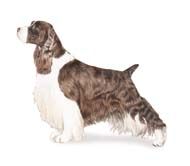
|
English Springer Spaniel Breed Standard
Sporting Group Sporting Group; AKC recognized in 1910. Average size: 40 to 50 pounds and 19 to 20 inches tall at the shoulder. Gun dog, versatile competitor. |
|
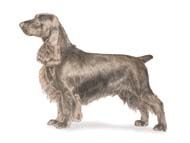
|
Field Spaniel Breed Standard
Sporting Group General Appearance The Field Spaniel is a combination of beauty and utility. It is a well balanced, substantial hunter-companion of medium size, built for activity and endurance in a heavy cover and water. It has a noble carriage; a proud but docile attitude; is sound and free moving. Symmetry, gait, attitude and purpose are more important than any one part. Size, Proportion, Substance Balance between these three components is essential. Size--Ideal height for mature adults at the withers is 18 inches for dogs and 17 inches for bitches. A one inch deviation either way is acceptable. Proportion--A well balanced dog, somewhat longer than tall. The ratio of length to height is approximately 7:6. (Length is measured on a level from the foremost point of the shoulder to the rearmost point of the buttocks.) Substance--Solidly built, with moderate bone, and firm smooth muscles. Head Conveys the impression of high breeding, character and nobility, and must be in proportion to the size of the dog. Expression--Grave, gentle and intelligent. Eyes--Almond in shape, open and of medium size; set moderately wide and deep. Color: dark hazel to dark brown. The lids are tight and show no haw; rims comparable to nose in color. Ears--Moderately long (reaching the end of the muzzle) and wide. Set on slightly below eye level: pendulous, hanging close to the head; rolled and well feathered. Leather is moderately heavy, supple, and rounded at the tip. Skull--The crown is slightly wider at the back than at the brow and lightly arched laterally; sides and cheeks are straight and clean. The occiput is distinct and rounded. Brows are slightly raised. The stop is moderate, but well defined by the brows. The face is chiselled beneath the eyes. Muzzle--Strong, long and lean, neither snipy nor squarely cut. The nasal bone is straight and slightly divergent from parallel, sloping downward toward the nose from the plane of the top skull. In profile, the lower plane curves gradually from the nose to the throat. Jaws are level. Nose--Large, flesh and well developed with open nostrils. Set on as an extension of the muzzle. Color: solid: light to dark brown or black as befits the color of the coat. Lips--Close fitting, clean, and sufficiently deep to cover the lower jaw without being pendulous. Bite--Scissors or level, with complete dentition. Scissors preferred. Neck, Topline, Body Neck--Long, strong, muscular, slightly arched, clean, and well set into shoulders. Topline--The neck slopes smoothly into the withers; the back is level, well muscled, firm and strong; the croup is short and gently rounded. Body--The prosternum is prominent and well fleshed. The depth of chest is roughly equal to the length of the front leg from elbow to ground. The rib cage is long and extending into a short loin. Ribs are oval, well sprung and curve gently into a firm loin. Loin--Short, strong, and deep, with little or no tuck up. Tail--Set on low, in line with the croup, just below the level of the back with a natural downward inclination. Docked tails preferred, natural tails are allowed. The tail whether docked or natural length should be in balance with the overall dog. Forequarters Shoulders blades are oblique and sloping. The upper arm is closed-set; elbows are directly below the withers, and turn neither in nor out. Bone is flat. Forelegs are straight and well boned to the feet. Pasterns are moderately sloping but strong. Dewclaws may be removed. Feet face forward and are large, rounded, and webbed, with strong, well arched relatively tight toes and thick pads. Hindquarters Strong and driving; stifles and hocks only moderately bent. Hocks well let down; pasterns relatively short, strong and parallel when viewed from the rear. Hips moderately broad and muscular; upper tigh broad and powerful; second thigh well muscled. Bone corresponds to that of the forelegs. No dewclaws. Coat Single; moderately long; flat or slightly wavy; silky; and glossy; dense and water-repellent. Moderate setter-like feathering adorns the chest, underbody, backs of the legs, buttocks, and may also be present on the second thigh and underside of the tail. Pasterns have clean outlines to the ground. There is short, soft hair between the toes. Overabundance of coat, or cottony texture, impractical for field work should be penalized. Trimming is limited to that which enhances the natural appearance of the dog. Amount of coat or absence of coat should not be faulted as much as structural faults. Color Black, liver, golden liver or shades thereof, in any intensity (dark or light); either self-colored or bi-colored. Bi-colored dogs must be roaned and/or ticked in white areas. Tan points are acceptable on the aforementioned colors and are the same as any normally tan pointed breed. White is allowed on the throat, chest, and/or brisket, and may be clear, ticked, or roaned on a self color dog. Gait The head is carried alertly, neither so high nor so low as to impede motion or stride. There is good forward reach that begins in the shoulder, coupled with strong drive from the rear, giving the characteristic effortless, long, low majestic stride. When viewed from front and/or rear elbows and hocks move parallel. The legs move straight, with slight converence at increased speed. When moving, the tail is carried inclined slightly downward or level with the back, and with a wagging motion. Tail carried above the back is incorrect. Side movement is straight and clean, without energy wasting motions. Over-reaching and single tracking are incorrect. The Field Spaniel should be show at its own natural speed in an endurance trot, preferably on a loose lead, in order to evaluate its movement. Temperament Unusually docile, sensitive, funloving, independent and intelligent, with a great affinity for human companionship. They may be somewhat reserved in initial meetings. Any display of shyness, fear, or agression is to be severely penalized. Approved September 14, 1998 Effective October 30, 1998 |
|

|
Flat-Coated Retriever Breed Standard
Sporting Group General Appearance The Flat-Coated Retriever is a versatile family companion hunting retriever with a happy and active demeanor, intelligent expression, and clean lines. The Flat-Coat has been traditionally described as showing "power without lumber and raciness without weediness." The distinctive and most important features of the Flat-Coat are the silhouette (both moving and standing), smooth effortless movement, head type, coat and character. In silhouette the Flat-Coat has a long, strong, clean, "one piece" head, which is unique to the breed. Free from exaggeration of stop or cheek, the head is set well into a moderately long neck which flows smoothly into well laid back shoulders. A level topline combined with a deep, long rib cage tapering to a moderate tuck-up create the impression of a blunted triangle. The brisket is well developed and the forechest forms a prominent prow. This utilitarian retriever is well balanced, strong, but elegant; never cobby, short legged or rangy. The coat is thick and flat lying, and the legs and tail are well feathered. A proud carriage, responsive attitude, waving tail and overall look of functional strength, quality, style and symmetry complete the picture of the typical Flat-Coat. Judging the Flat-Coat moving freely on a loose lead and standing naturally is more important than judging him posed. Honorable scars should not count against the dog. Size, Proportion, Substance Size--Individuals varying more than an inch either way from the preferred height should be considered not practical for the types of work for which the Flat-Coat was developed. Preferred height is 23 to 24½; inches at the withers for dogs, 22 to 23½ inches for bitches. Since the Flat-Coat is a working hunting retriever he should be shown in lean, hard condition, free of excess weight. Proportion--The Flat-Coat is not cobby in build. The length of the body from the point of the shoulder to the rearmost projection of the upper thigh is slightly more than the height at the withers. The female may be slightly longer to better accommodate the carrying of puppies. Substance-- Moderate. Medium bone is flat or oval rather than round; strong but never massive, coarse, weedy or fine. This applies throughout the dog. Head The long, clean, well molded head is adequate in size and strength to retrieve a large pheasant, duck or hare with ease. Skull and Muzzle--The impression of the skull and muzzle being "cast in one piece" is created by the fairly flat skull of moderate breadth and flat, clean cheeks, combined with the long, strong, deep muzzle which is well filled in before, between and beneath the eyes. Viewed from above, the muzzle is nearly equal in length and breadth to the skull. Stop--There is a gradual, slight, barely perceptible stop, avoiding a down or dish-faced appearance. Brows are slightly raised and mobile, giving life to the expression. Stop must be evaluated in profile so that it will not be confused with the raised brow. Occiput not accentuated, the skull forming a gentle curve where it fits well into the neck. Expression alert, intelligent and kind. Eyes are set widely apart. Medium sized, almond shaped, dark brown or hazel; not large, round or yellow. Eye rims are self-colored and tight. Ears relatively small, well set on, lying close to the side of the head and thickly feathered. Not low set (houndlike or setterish). Nose--Large open nostrils. Black on black dogs, brown on liver dogs. Lips fairly tight, firm, clean and dry to minimize the retention of feathers. Jaws long and strong, capable of carrying a hare or a pheasant. Bite-- Scissors bite preferred, level bite acceptable. Broken teeth should not count against the dog. Severe Faults Wry and undershot or overshot bites with a noticeable gap must be severely penalized. Neck, Topline, Body Neck strong and slightly arched for retrieving strength. Moderately long to allow for easy seeking of the trail. Free from throatiness. Coat on neck is untrimmed. Topline strong and level. Body--Chest (Brisket)--Deep, reaching to the elbow and only moderately broad. Forechest--Prow prominent and well developed. Rib cage deep, showing good length from forechest to last rib (to allow ample space for all body organs), and only moderately broad. The foreribs fairly flat showing a gradual spring, well arched in the center of the body but rather lighter towards the loin. Underline--Deep chest tapering to a moderate tuck-up. Loin strong, well muscled and long enough to allow for agility, freedom of movement and length of stride, but never weak or loosely coupled. Croup slopes very slightly; rump moderately broad and well muscled. Tail fairly straight, well set on, with bone reaching approximately to the hock joint. When the dog is in motion, the tail is carried happily but without curl as a smooth extension of the topline, never much above the level of the back. Forequarters Shoulders long, well laid back shoulder blade with upper arm of approximately equal length to allow for efficient reach. Musculature wiry rather than bulky. Elbows clean, close to the body and set well back under the withers. Forelegs straight and strong with medium bone of good quality. Pasterns slightly sloping and strong. Dewclaws--Removal of dewclaws is optional. Feet oval or round. Medium sized and tight with well arched toes and thick pads. Hindquarters Powerful with angulation in balance with the front assembly. Upper thighs powerful and well muscled. Stifle--Good turn of stifle with sound, strong joint. Second thighs (Stifle to hock joint)--Second or lower thigh as long as or only slightly longer than upper thight. Hock--Hock joint strong, well let down. Dewclaws There are no hind dewclaws. Feet oval or round. Medium sized and tight with well arched toes and thick pads. Coat Coat is of moderate length density and fullness, with a high lustre. The ideal coat is straight and flat lying. A slight waviness is permissible but the coat is not curly, wooly, short, silky or fluffy. The Flat-Coat is a working retriever and the coat must provide protection from all types of weather, water and ground cover. This requires a coat of sufficient texture, length and fullness to allow for adequate insulation. When the dog is in full coat the ears, front, chest, back of forelegs, thighs and underside of tail are thickly feathered without being bushy, stringy or silky. Mane of longer heavier coat on the neck extending over the withers and shoulders is considered typical, especially in the male dog, and can cause the neck to appear thicker and the withers higher, sometimes causing the appearance of a dip behind the withers. Since the Flat-Coat is a hunting retriever, the feathering is not excessively long. Trimming --The Flat-Coat is shown with as natural a coat as possible and must not be penalized for lack of trimming, as long as the coat is clean and well brushed. Tidying of ears, feet, underline and tip of tail is acceptable. Whiskers serve a specific function and it is preferred that they not be trimmed. Shaving or barbering of the head, neck or body coat must be severely penalized. Color Solid black or solid liver. Disqualification-- Yellow, cream or any color other than black or liver. Gait Sound, efficient movement is of critical importance to a hunting retriever. The Flat-Coat viewed from the side covers ground efficiently and movement appears balanced, free flowing and well coordinated, never choppy, mincing or ponderous. Front and rear legs reach well forward and extend well back, achieving long clean strides. Topline appears level, strong and supple while dog is in motion. Summary The Flat-Coat is a strong but elegant, cheerful hunting retriever. Quality of structure, balance and harmony of all parts both standing and in motion are essential. As a breed whose purpose is of a utilitarian nature, structure, condition and attitude should give every indication of being suited for hard work. Temperament Character is a primary and outstanding asset of the Flat-Coat. He is a responsive, loving member of the family, a versatile working dog, multi-talented, sensible, bright and tractable. In competition the Flat-Coat demonstrates stability and a desire to please with a confident, happy and outgoing attitude characterized by a wagging tail. Nervous, hyperactive, apathetic, shy or obstinate behavior is undesirable. Severe Fault--Unprovoked aggressive behavior toward people or animals is totally unacceptable. Character Character is as important to the evaluation of stock by a potential breeder as any other aspect of the breed standard. The Flat-Coat is primarily a family companion hunting retriever. He is keen and birdy, flushing within gun range, as well as a determined, resourceful retriever on land and water. He has a great desire to hunt with self-reliance and an uncanny ability to adapt to changing circumstances on a variety of upland game and waterfowl. As a family companion he is sensible, alert and highly intelligent; a lighthearted, affectionate and adaptable friend. He retains these qualities as well as his youthfully good-humored outlook on life into old age. The adult Flat-Coat is usually an adequate alarm dog to give warning, but is a good-natured, optimistic dog, basically inclined to be friendly to all. The Flat-Coat is a cheerful, devoted companion who requires and appreciates living with and interacting as a member of his family. To reach full potential in any endeavor he absolutely must have a strong personal bond and affectionate individual attention. Disqualification Yellow, cream or any color other than black or liver. Approved September 11, 1990 Effective October 30, 1990 |
|
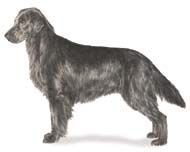
|
Flat-Coated Retriever Breed Standard
Sporting Group General Appearance The Flat-Coated Retriever is a versatile family companion hunting retriever with a happy and active demeanor, intelligent expression, and clean lines. The Flat-Coat has been traditionally described as showing "power without lumber and raciness without weediness." The distinctive and most important features of the Flat-Coat are the silhouette (both moving and standing), smooth effortless movement, head type, coat and character. In silhouette the Flat-Coat has a long, strong, clean, "one piece" head, which is unique to the breed. Free from exaggeration of stop or cheek, the head is set well into a moderately long neck which flows smoothly into well laid back shoulders. A level topline combined with a deep, long rib cage tapering to a moderate tuck-up create the impression of a blunted triangle. The brisket is well developed and the forechest forms a prominent prow. This utilitarian retriever is well balanced, strong, but elegant; never cobby, short legged or rangy. The coat is thick and flat lying, and the legs and tail are well feathered. A proud carriage, responsive attitude, waving tail and overall look of functional strength, quality, style and symmetry complete the picture of the typical Flat-Coat. Judging the Flat-Coat moving freely on a loose lead and standing naturally is more important than judging him posed. Honorable scars should not count against the dog. Size, Proportion, Substance Size--Individuals varying more than an inch either way from the preferred height should be considered not practical for the types of work for which the Flat-Coat was developed. Preferred height is 23 to 24½; inches at the withers for dogs, 22 to 23½ inches for bitches. Since the Flat-Coat is a working hunting retriever he should be shown in lean, hard condition, free of excess weight. Proportion--The Flat-Coat is not cobby in build. The length of the body from the point of the shoulder to the rearmost projection of the upper thigh is slightly more than the height at the withers. The female may be slightly longer to better accommodate the carrying of puppies. Substance-- Moderate. Medium bone is flat or oval rather than round; strong but never massive, coarse, weedy or fine. This applies throughout the dog. Head The long, clean, well molded head is adequate in size and strength to retrieve a large pheasant, duck or hare with ease. Skull and Muzzle--The impression of the skull and muzzle being "cast in one piece" is created by the fairly flat skull of moderate breadth and flat, clean cheeks, combined with the long, strong, deep muzzle which is well filled in before, between and beneath the eyes. Viewed from above, the muzzle is nearly equal in length and breadth to the skull. Stop--There is a gradual, slight, barely perceptible stop, avoiding a down or dish-faced appearance. Brows are slightly raised and mobile, giving life to the expression. Stop must be evaluated in profile so that it will not be confused with the raised brow. Occiput not accentuated, the skull forming a gentle curve where it fits well into the neck. Expression alert, intelligent and kind. Eyes are set widely apart. Medium sized, almond shaped, dark brown or hazel; not large, round or yellow. Eye rims are self-colored and tight. Ears relatively small, well set on, lying close to the side of the head and thickly feathered. Not low set (houndlike or setterish). Nose--Large open nostrils. Black on black dogs, brown on liver dogs. Lips fairly tight, firm, clean and dry to minimize the retention of feathers. Jaws long and strong, capable of carrying a hare or a pheasant. Bite-- Scissors bite preferred, level bite acceptable. Broken teeth should not count against the dog. Severe Faults Wry and undershot or overshot bites with a noticeable gap must be severely penalized. Neck, Topline, Body Neck strong and slightly arched for retrieving strength. Moderately long to allow for easy seeking of the trail. Free from throatiness. Coat on neck is untrimmed. Topline strong and level. Body--Chest (Brisket)--Deep, reaching to the elbow and only moderately broad. Forechest--Prow prominent and well developed. Rib cage deep, showing good length from forechest to last rib (to allow ample space for all body organs), and only moderately broad. The foreribs fairly flat showing a gradual spring, well arched in the center of the body but rather lighter towards the loin. Underline--Deep chest tapering to a moderate tuck-up. Loin strong, well muscled and long enough to allow for agility, freedom of movement and length of stride, but never weak or loosely coupled. Croup slopes very slightly; rump moderately broad and well muscled. Tail fairly straight, well set on, with bone reaching approximately to the hock joint. When the dog is in motion, the tail is carried happily but without curl as a smooth extension of the topline, never much above the level of the back. Forequarters Shoulders long, well laid back shoulder blade with upper arm of approximately equal length to allow for efficient reach. Musculature wiry rather than bulky. Elbows clean, close to the body and set well back under the withers. Forelegs straight and strong with medium bone of good quality. Pasterns slightly sloping and strong. Dewclaws--Removal of dewclaws is optional. Feet oval or round. Medium sized and tight with well arched toes and thick pads. Hindquarters Powerful with angulation in balance with the front assembly. Upper thighs powerful and well muscled. Stifle--Good turn of stifle with sound, strong joint. Second thighs (Stifle to hock joint)--Second or lower thigh as long as or only slightly longer than upper thight. Hock--Hock joint strong, well let down. Dewclaws There are no hind dewclaws. Feet oval or round. Medium sized and tight with well arched toes and thick pads. Coat Coat is of moderate length density and fullness, with a high lustre. The ideal coat is straight and flat lying. A slight waviness is permissible but the coat is not curly, wooly, short, silky or fluffy. The Flat-Coat is a working retriever and the coat must provide protection from all types of weather, water and ground cover. This requires a coat of sufficient texture, length and fullness to allow for adequate insulation. When the dog is in full coat the ears, front, chest, back of forelegs, thighs and underside of tail are thickly feathered without being bushy, stringy or silky. Mane of longer heavier coat on the neck extending over the withers and shoulders is considered typical, especially in the male dog, and can cause the neck to appear thicker and the withers higher, sometimes causing the appearance of a dip behind the withers. Since the Flat-Coat is a hunting retriever, the feathering is not excessively long. Trimming --The Flat-Coat is shown with as natural a coat as possible and must not be penalized for lack of trimming, as long as the coat is clean and well brushed. Tidying of ears, feet, underline and tip of tail is acceptable. Whiskers serve a specific function and it is preferred that they not be trimmed. Shaving or barbering of the head, neck or body coat must be severely penalized. Color Solid black or solid liver. Disqualification-- Yellow, cream or any color other than black or liver. Gait Sound, efficient movement is of critical importance to a hunting retriever. The Flat-Coat viewed from the side covers ground efficiently and movement appears balanced, free flowing and well coordinated, never choppy, mincing or ponderous. Front and rear legs reach well forward and extend well back, achieving long clean strides. Topline appears level, strong and supple while dog is in motion. Summary The Flat-Coat is a strong but elegant, cheerful hunting retriever. Quality of structure, balance and harmony of all parts both standing and in motion are essential. As a breed whose purpose is of a utilitarian nature, structure, condition and attitude should give every indication of being suited for hard work. Temperament Character is a primary and outstanding asset of the Flat-Coat. He is a responsive, loving member of the family, a versatile working dog, multi-talented, sensible, bright and tractable. In competition the Flat-Coat demonstrates stability and a desire to please with a confident, happy and outgoing attitude characterized by a wagging tail. Nervous, hyperactive, apathetic, shy or obstinate behavior is undesirable. Severe Fault--Unprovoked aggressive behavior toward people or animals is totally unacceptable. Character Character is as important to the evaluation of stock by a potential breeder as any other aspect of the breed standard. The Flat-Coat is primarily a family companion hunting retriever. He is keen and birdy, flushing within gun range, as well as a determined, resourceful retriever on land and water. He has a great desire to hunt with self-reliance and an uncanny ability to adapt to changing circumstances on a variety of upland game and waterfowl. As a family companion he is sensible, alert and highly intelligent; a lighthearted, affectionate and adaptable friend. He retains these qualities as well as his youthfully good-humored outlook on life into old age. The adult Flat-Coat is usually an adequate alarm dog to give warning, but is a good-natured, optimistic dog, basically inclined to be friendly to all. The Flat-Coat is a cheerful, devoted companion who requires and appreciates living with and interacting as a member of his family. To reach full potential in any endeavor he absolutely must have a strong personal bond and affectionate individual attention. Disqualification Yellow, cream or any color other than black or liver. Approved September 11, 1990 Effective October 30, 1990 |
|
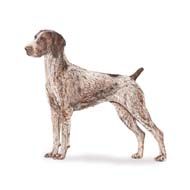
|
German Shorthaired Pointer Breed Standard
Sporting Group Sporting Group; AKC recognized in 1930. Average size: 55 to 70 pounds and 23 to 25 inches tall at the shoulder. Gun dog, family pet. |
|
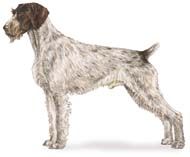
|
German Wirehaired Pointer Breed Standard
Sporting Group General Appearance The German Wirehaired Pointer is a well muscled, medium sized dog of distinctive appearance. Balanced in size and sturdily built, the breed’s most distinguishing characteristics are its weather resistant, wire-like coat and its facial furnishings. Typically Pointer in character and style, the German Wirehaired Pointer is an intelligent, energetic and determined hunter. Size, Proportion, Substance The height of males should be from 24 to 26 inches at the withers. Bitches are smaller but not under 22 inches. To insure the working quality of the breed is maintained, dogs that are either over or under the specified height must be severely penalized. The body is a little longer than it is high, as ten is to nine. The German Wirehaired Pointer is a versatile hunter built for agility and endurance in the field. Correct size and balance are essential to high performance. Head The head is moderately long. Eyes are brown, medium in size, oval in contour, bright and clear and overhung with medium length eyebrows. Yellow eyes are not desirable. The ears are rounded but not too broad and hang close to the head. The skull broad and the occipital bone not too prominent. The stop is medium. The muzzle is fairly long with nasal bone straight, broad and parallel to the top of the skull. The nose is dark brown with nostrils wide open. A spotted or flesh colored nose is to be penalized. The lips are a trifle pendulous but close to the jaw and bearded. The jaws are strong with a full complement of evenly set and properly intermeshing teeth. The incisors meet in a true scissors bite. Neck, Topline, Body The neck is of medium length, slightly arched and devoid of dewlap. The entire back line showing a perceptible slope down from withers to croup. The skin throughout is notably tight to the body. The chest is deep and capacious with ribs well sprung. The tuck-up apparent. The back is short, straight and strong. Loins are taut and slender. Hips are broad with the croup nicely rounded. The tail is set high, carried at or above the horizontal when the dog is alert. The tail is docked to approximately two-fifths of its original length. Forequarters The shoulders are well laid back. The forelegs are straight with elbows close. Leg bones are flat rather than round, and strong, but not so heavy or coarse as to militate against the dog’s natural agility. Dewclaws are generally removed. Round in outline the feet are webbed, high arched with toes close, pads thick and hard, and nails strong and quite heavy. Hindquarters The angles of the hindquarters balances that of the forequarters. A straight line drawn vertically from the buttock (ischium) to the ground should land just in front of the rear foot. The thighs are strong and muscular. The hind legs are parallel when viewed from the rear. The hocks (metatarsus) are short, straight and parallel turning neither in nor out. Dewclaws are generally removed. Feet as in forequarters. Coat The functional wiry coat is the breed’s most distinctive feature. A dog must have a correct coat to be of correct type. The coat is weather resistant and, to some extent, water-repellent. The undercoat is dense enough in winter to insulate against the cold but is so thin in summer as to be almost invisible. The distinctive outer coat is straight, harsh, wiry and flat lying, and is from one to two inches in length. The outer coat is long enough to protect against the punishment of rough cover, but not so long as to hide the outline of the dog. On the lower legs the coat is shorter and between the toes it is of softer texture. On the skull the coat is naturally short and close fitting. Over the shoulders and around the tail it is very dense and heavy. The tail is nicely coated, particularly on the underside, but devoid of feather. Eyebrows are of strong, straight hair. Beard and whiskers are medium length. The hairs in the liver patches of a liver and white dog may be shorter than the white hairs. A short smooth coat, a soft woolly coat, or an excessively long coat is to be severely penalized. While maintaining a harsh, wiry texture, the puppy coat may be shorter than that of an adult coat. Coats may be neatly groomed to present a dog natural in appearance. Extreme and excessive grooming to present a dog artificial in appearance should be severely penalized. Color The coat is liver and white, usually either liver and white spotted, liver roan, liver and white spotted with ticking and roaning or solid liver. The head is liver, sometimes with a white blaze. The ears are liver. Any black in the coat is to be severely penalized. Gait The dog should be evaluated at a moderate gait. Seen from the side, the movement is free and smooth with good reach in the forequarters and good driving power in the hindquarters. The dog carries a firm back and exhibits a long, ground-covering stride. When moving in a straight line the legs swing forward in a free and easy manner and show no tendency to cross or interfere. There should be no signs of elbowing out. The rear legs follow on a line with the forelegs. As speed increases, the legs will converge toward a center line of travel. Temperament Of sound, reliable temperament, the German Wirehaired Pointer is at times aloof but not unfriendly toward strangers; a loyal and affectionate companion who is eager to please and enthusiastic to learn. Approved October 10, 2006 Effective January 1, 2007 |
|
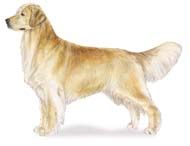
|
Golden Retriever Breed Standard
Sporting Group Sporting Group; AKC recognized in 1932. Average size: from 55 to 75 pounds. Devoted companions, hunting dog. |
|
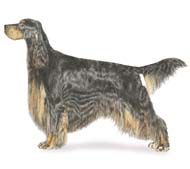
|
Gordon Setter Breed Standard
Sporting Group General Appearance The Gordon Setter is a good-sized, sturdily built, black and tan dog, well muscled, with plenty of bone and substance, but active, upstanding and stylish, appearing capable of doing a full day’s work in the field. He has a strong, rather short back, with well sprung ribs and a short tail. The head is fairly heavy and finely chiseled. His bearing is intelligent, noble, and dignified, showing no signs of shyness or viciousness. Clear colors and straight or slightly waved coat are correct. He suggests strength and stamina rather than extreme speed. Symmetry and quality are most essential. A dog well balanced in all points is preferable to one with outstanding good qualities and defects. A smooth, free movement, with high head carriage, is typical. Size, Proportion, Substance Size--Shoulder height for males, 24 to 27 inches; females, 23 to 26 inches. Weight for males, 55 to 80 pounds; females, 45 to 70 pounds. Animals that appear to be over or under the prescribed weight limits are to be judged on the basis of conformation and condition. Extremely thin or fat dogs are discouraged on the basis that under or overweight hampers the true working ability of the Gordon Setter. The weight-to-height ratio makes him heavier than other Setters. Proportion The distance from the forechest to the back of the thigh is approximately equal the height from the ground to the withers. The Gordon Setter has plenty of bone and substance. Head Head deep, rather than broad, with plenty of brain room. Eyes of fair size, neither too deep-set nor too bulging, dark brown, bright and wise. The shape is oval rather than round. The lids are tight. Ears set low on the head approximately on line with the eyes, fairly large and thin, well folded and carried close to the head. Skull nicely rounded, good-sized, broadest between the ears. Below and above the eyes is lean and the cheeks as narrow as the leanness of the head allows. The head should have a clearly indicated stop. Muzzle fairly long and not pointed, either as seen from above or from the side. The flews are not pendulous. The muzzle is the same length as the skull from occiput to stop and the top of the muzzle is parallel to the line of the skull extended. Nose broad, with open nostrils and black in color. The lip line from the nose to the flews shows a sharp, well-defined, square contour. Teeth strong and white, meeting in front in a scissors bite, with the upper incisors slightly forward of the lower incisors. A level bite is not a fault. Pitted teeth from distemper or allied infections are not penalized. Neck, Topline, Body Neck long, lean, arched to the head, and without throatiness. Topline moderately sloping. Body short from shoulder to hips. Chest deep and not too broad in front; the ribs well sprung, leaving plenty of lung room. The chest reaches to the elbows. A pronounced forechest is in evidence. Loins short and broad and not arched. Croup nearly flat, with only a slight slope to the tailhead. Tail short and not reaching below the hocks, carried horizontal or nearly so, not docked, thick at the root and finishing in a fine point. The placement of the tail is important for correct carriage. When the angle of the tail bends too sharply at the first coccygeal bone, the tail will be carried too gaily or will droop. The tail placement is judged in relationship to the structure of the croup. Forequarters Shoulders fine at the points, and laying well back. The tops of the shoulder blades are close together. When viewed from behind, the neck appears to fit into the shoulders in smooth, flat lines that gradually widen from neck to shoulder. The angle formed by the shoulder blade and upper arm bone is approximately 90 degrees when the dog is standing so that the foreleg is perpendicular to the ground. Forelegs big-boned, straight and not bowed, with elbows free and not turned in or out. Pasterns are strong, short and nearly vertical with a slight spring. Dewclaws may be removed. Feet catlike in shape, formed by close-knit, well arched toes with plenty of hair between; with full toe pads and deep heel cushions. Feet are not turned in or out. Hindquarters The hind legs from hip to hock are long, flat and muscular; from hock to heel, short and strong. The stifle and hock joints are well bent and not turned either in or out. When the dog is standing with the rear pastern perpendicular to the ground, the thighbone hangs downward parallel to an imaginary line drawn upward from the hock. Feet as in front. Coat Soft and shining, straight or slightly waved, but not curly, with long hair on ears, under stomach and on chest, on back of the fore and hind legs, and on the tail. The feather which starts near the root of the tail is slightly waved or straight, having a triangular appearance, growing shorter uniformly toward the end. Color and Markings Black with tan markings, either of rich chestnut or mahogany color. Black pencilling is allowed on the toes. The borderline between black and tan colors is clearly defined. There are not any tan hairs mixed in the black. The tan markings are located as follows: (1) Two clear spots over the eyes and not over three-quarters of an inch in diameter; (2) On the sides of the muzzle. The tan does not reach to the top of the muzzle, but resembles a stripe around the end of the muzzle from one side to the other; (3) On the throat; (4) Two large clear spots on the chest; (5) On the inside of the hind legs showing down the front of the stifle and broadening out to the outside of the hind legs from the hock to the toes. It must not completely eliminate the black on the back of the hind legs; (6) On the forelegs from the carpus, or a little above, downward to the toes; (7) Around the vent; (8) A white spot on the chest is allowed, but the smaller the better. Predominantly tan, red or buff dogs which do not have the typical pattern of markings of a Gordon Setter are ineligible for showing and undesirable for breeding. Predominantly tan, red or buff dogs are ineligible for showing and undesirable for breeding. Gait A bold, strong, driving free-swinging gait. The head is carried up and the tail "flags" constantly while the dog is in motion. When viewed from the front the forefeet move up and down in straight lines so that the shoulder, elbow and pastern joints are approximately in line. When viewed from the rear the hock, stifle and hip joints are approximately in line. Thus the dog moves in a straight pattern forward without throwing the feet in or out. When viewed from the side the forefeet are seen to lift up and reach forward to compensate for the driving hindquarters. The hindquarters reach well forward and stretch far back, enabling the stride to be long and the drive powerful. The overall appearance of the moving dog is one of smooth-flowing, well balanced rhythm, in which the action is pleasing to the eye, effortless, economical and harmonious. Temperament The Gordon Setter is alert, gay, interested, and confident. He is fearless and willing, intelligent and capable. He is loyal and affectionate, and strong-minded enough to stand the rigors of training. Disqualification Predominantly tan, red or buff dogs. Scale of Points To be used as a guide when judging the Gordon Setter: Head and neck (include ears and eyes) 10 Body 15 Shoulders, forelegs, forefeet 10 Hind legs and feet 10 Tail 5 Coat 8 Color and markings 5 Temperament 10 Size, general appearance 15 Gait 12 Total 100 Approved October 7, 2002 Effective November 27, 2002 |
|
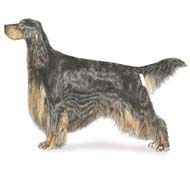
|
Gordon Setter Breed Standard
Sporting Group General Appearance The Gordon Setter is a good-sized, sturdily built, black and tan dog, well muscled, with plenty of bone and substance, but active, upstanding and stylish, appearing capable of doing a full day’s work in the field. He has a strong, rather short back, with well sprung ribs and a short tail. The head is fairly heavy and finely chiseled. His bearing is intelligent, noble, and dignified, showing no signs of shyness or viciousness. Clear colors and straight or slightly waved coat are correct. He suggests strength and stamina rather than extreme speed. Symmetry and quality are most essential. A dog well balanced in all points is preferable to one with outstanding good qualities and defects. A smooth, free movement, with high head carriage, is typical. Size, Proportion, Substance Size--Shoulder height for males, 24 to 27 inches; females, 23 to 26 inches. Weight for males, 55 to 80 pounds; females, 45 to 70 pounds. Animals that appear to be over or under the prescribed weight limits are to be judged on the basis of conformation and condition. Extremely thin or fat dogs are discouraged on the basis that under or overweight hampers the true working ability of the Gordon Setter. The weight-to-height ratio makes him heavier than other Setters. Proportion The distance from the forechest to the back of the thigh is approximately equal the height from the ground to the withers. The Gordon Setter has plenty of bone and substance. Head Head deep, rather than broad, with plenty of brain room. Eyes of fair size, neither too deep-set nor too bulging, dark brown, bright and wise. The shape is oval rather than round. The lids are tight. Ears set low on the head approximately on line with the eyes, fairly large and thin, well folded and carried close to the head. Skull nicely rounded, good-sized, broadest between the ears. Below and above the eyes is lean and the cheeks as narrow as the leanness of the head allows. The head should have a clearly indicated stop. Muzzle fairly long and not pointed, either as seen from above or from the side. The flews are not pendulous. The muzzle is the same length as the skull from occiput to stop and the top of the muzzle is parallel to the line of the skull extended. Nose broad, with open nostrils and black in color. The lip line from the nose to the flews shows a sharp, well-defined, square contour. Teeth strong and white, meeting in front in a scissors bite, with the upper incisors slightly forward of the lower incisors. A level bite is not a fault. Pitted teeth from distemper or allied infections are not penalized. Neck, Topline, Body Neck long, lean, arched to the head, and without throatiness. Topline moderately sloping. Body short from shoulder to hips. Chest deep and not too broad in front; the ribs well sprung, leaving plenty of lung room. The chest reaches to the elbows. A pronounced forechest is in evidence. Loins short and broad and not arched. Croup nearly flat, with only a slight slope to the tailhead. Tail short and not reaching below the hocks, carried horizontal or nearly so, not docked, thick at the root and finishing in a fine point. The placement of the tail is important for correct carriage. When the angle of the tail bends too sharply at the first coccygeal bone, the tail will be carried too gaily or will droop. The tail placement is judged in relationship to the structure of the croup. Forequarters Shoulders fine at the points, and laying well back. The tops of the shoulder blades are close together. When viewed from behind, the neck appears to fit into the shoulders in smooth, flat lines that gradually widen from neck to shoulder. The angle formed by the shoulder blade and upper arm bone is approximately 90 degrees when the dog is standing so that the foreleg is perpendicular to the ground. Forelegs big-boned, straight and not bowed, with elbows free and not turned in or out. Pasterns are strong, short and nearly vertical with a slight spring. Dewclaws may be removed. Feet catlike in shape, formed by close-knit, well arched toes with plenty of hair between; with full toe pads and deep heel cushions. Feet are not turned in or out. Hindquarters The hind legs from hip to hock are long, flat and muscular; from hock to heel, short and strong. The stifle and hock joints are well bent and not turned either in or out. When the dog is standing with the rear pastern perpendicular to the ground, the thighbone hangs downward parallel to an imaginary line drawn upward from the hock. Feet as in front. Coat Soft and shining, straight or slightly waved, but not curly, with long hair on ears, under stomach and on chest, on back of the fore and hind legs, and on the tail. The feather which starts near the root of the tail is slightly waved or straight, having a triangular appearance, growing shorter uniformly toward the end. Color and Markings Black with tan markings, either of rich chestnut or mahogany color. Black pencilling is allowed on the toes. The borderline between black and tan colors is clearly defined. There are not any tan hairs mixed in the black. The tan markings are located as follows: (1) Two clear spots over the eyes and not over three-quarters of an inch in diameter; (2) On the sides of the muzzle. The tan does not reach to the top of the muzzle, but resembles a stripe around the end of the muzzle from one side to the other; (3) On the throat; (4) Two large clear spots on the chest; (5) On the inside of the hind legs showing down the front of the stifle and broadening out to the outside of the hind legs from the hock to the toes. It must not completely eliminate the black on the back of the hind legs; (6) On the forelegs from the carpus, or a little above, downward to the toes; (7) Around the vent; (8) A white spot on the chest is allowed, but the smaller the better. Predominantly tan, red or buff dogs which do not have the typical pattern of markings of a Gordon Setter are ineligible for showing and undesirable for breeding. Predominantly tan, red or buff dogs are ineligible for showing and undesirable for breeding. Gait A bold, strong, driving free-swinging gait. The head is carried up and the tail "flags" constantly while the dog is in motion. When viewed from the front the forefeet move up and down in straight lines so that the shoulder, elbow and pastern joints are approximately in line. When viewed from the rear the hock, stifle and hip joints are approximately in line. Thus the dog moves in a straight pattern forward without throwing the feet in or out. When viewed from the side the forefeet are seen to lift up and reach forward to compensate for the driving hindquarters. The hindquarters reach well forward and stretch far back, enabling the stride to be long and the drive powerful. The overall appearance of the moving dog is one of smooth-flowing, well balanced rhythm, in which the action is pleasing to the eye, effortless, economical and harmonious. Temperament The Gordon Setter is alert, gay, interested, and confident. He is fearless and willing, intelligent and capable. He is loyal and affectionate, and strong-minded enough to stand the rigors of training. Disqualification Predominantly tan, red or buff dogs. Scale of Points To be used as a guide when judging the Gordon Setter: Head and neck (include ears and eyes) 10 Body 15 Shoulders, forelegs, forefeet 10 Hind legs and feet 10 Tail 5 Coat 8 Color and markings 5 Temperament 10 Size, general appearance 15 Gait 12 Total 100 Approved October 7, 2002 Effective November 27, 2002 |
|
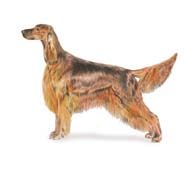
|
Irish Setter Breed Standard
Sporting Group Sporting Group; AKC recognized in 1878. Average size: 60 to 70 pounds and 25 to 27 inches tall at the shoulder. Bird dog, show dog. |
|
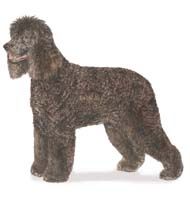
|
Irish Water Spaniel Breed Standard
Sporting Group General Appearance The Irish Water Spaniel presents a picture of a smart, upstanding strongly built sporting dog. Great intelligence is combined with rugged endurance and a bold, dashing eagerness of temperament. Distinguishing characteristics are a topknot of long, loose curls, a body covered with a dense, crisply curled liver colored coat, contrasted by a smooth face and a smooth "rat" tail. Size, Proportion, Substance Strongly built and well boned, the Irish Water Spaniel is a dog of medium length, slightly rectangular in appearance. He is well balanced and shows no legginess or coarseness. Dogs 22 to 24 inches, bitches 21 to 23 inches, measured at the highest point of the shoulder. Dogs 55 to 65 pounds, bitches 45 to 58 pounds. Head The head is cleanly chiseled, not cheeky, and should not present a short, wedge shaped appearance. The skull is rather large and high in the dome, with a prominent occiput and a gradual stop. The muzzle is square and rather long, with a deep mouth opening and lips fine in texture. The nose large and liver in color. Teeth strong and regular with a scissors or level bite. The hair on the face is short and smooth, except for a beard which grows in a narrow line at the back of the jaw. Topknot--A characteristic of the breed, consists of long, loose curls growing down into a well-defined peak between the eyes and falling like a shawl over the tops of the ears and occiput. Trimming of this breed characteristic in an exaggerated manner is highly objectionable. Eyes--Medium in size, slightly almond shaped with tight eyelids. Eyes are hazel in color, preferably of a dark shade. The expression is keenly alert, intelligent, direct and quizzical. Ears--Long, lobular, set low, with leathers reaching about to the end of the nose when extended forward, and abundantly covered with long curls, extending two or more inches below the tips of the leathers. Neck, Topline, Body The neck is long, arching, strong and muscular; smoothly set into cleanly sloping shoulders. Topline--Strong and level, or slightly higher in the rear; never descending, or showing sag or roach. Body--The body is of medium length, slightly rectangular. Chest deep, with brisket extending to the elbows. Ribs well sprung and carried well back. Immediately behind the shoulders ribs are flattened enough to allow free movement of the forelegs, becoming rounder behind. Loin short, wide and muscular. The body should not present a tucked-up appearance. Forequarters The entire front gives the impression of strength without heaviness. Shoulders are sloping and clean. Forelegs well boned, muscular, medium in length; with sufficient length of upper arm to ensure efficient reach. Elbows close set. Forefeet are large, thick and somewhat spreading; well clothed with hair both over and between the toes. Hindquarters Sound hindquarters are of great importance to provide swimming power and drive. They should be as high or slightly higher than the shoulders, powerful and muscular, with well developed upper and second thighs. Hips wide, stifles moderately bent, hocks low set and moderately bent. Rear angulation is moderate, and balance of front and rear angulation is of paramount importance. Rear feet are large, thick and somewhat spreading; well clothed with hair. Tail should be set on low enough to give a rather rounded appearance to the hindquarters and should be carried nearly level with the back. Tail The so-called "rat tail" is a striking characteristic of the breed. At the root it is thick and covered for two or three inches with short curls. It tapers to a fine point at the end; and from the root curls is covered with short, smooth hair so as to look as if it had been clipped. The tail should not be long enough to reach the hock joint. Coat Proper double coat is of vital importance to protect the dog while working. The neck, back, sides, and rear are densely covered with tight, crisp ringlets, with the hair longer underneath the ribs. Forelegs are well covered with abundant curls or waves. The hind legs should also be abundantly covered by hair falling in curls or waves, except that the hair should be short and smooth on the front of the legs below the hocks. The hair on the throat is very short and smooth, forming a V-shaped patch. All curled areas should be clearly defined by curls of sufficient length to form a sharp contrast with the smooth coat on face, throat, tail, and rear legs below the hocks. Fore and hind feet should be well clothed with hair both over and between the toes. Dogs may be shown in natural coat or trimmed. However, no dog should be groomed or trimmed so excessively as to obscure the curl or texture of the coat. Color Solid liver. With the exception of graying due to age, white hair or markings objectionable. Gait The Irish Water Spaniel moves with a smooth, free, ground covering action that, when viewed from the side, exhibits balanced reach and drive. True and precise coming and going. When walking or standing, the legs are perpendicular to the ground, toeing neither in nor out. Temperament Very alert and inquisitive, the Irish Water Spaniel is often reserved with strangers. However, aggressive behavior or excessive shyness should be penalized. A stable temperament is essential in a hunting dog. Faults The foregoing description is that of the ideal Irish Water Spaniel in hard working condition. Any deviation from the above described dog must be penalized to the extent of the deviation, keeping in mind the importance of the various features toward the basic original purpose of the breed. Approved June 12, 1990 Effective August 1, 1990 |
|
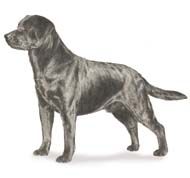
|
Labrador Retriever Breed Standard
Sporting Group Sporting Group; AKC recognized in 1917 Average size: from 55 to 75 pounds Outgoing and devoted companions; Water dog |
|

|
Nova Scotia Duck Tolling Retriever Breed Standard
Sporting Group General Appearance The Nova Scotia Duck Tolling Retriever (Toller) was developed in the early 19th century to toll, lure, and retrieve waterfowl. The playful action of the Toller retrieving a stick or ball along the shoreline arouses the curiosity of the ducks offshore. They are lured within gunshot range, and the dog is sent out to retrieve the dead or wounded birds. This medium sized, powerful, compact, balanced dog is the smallest of the retrievers. The Toller's attitude and bearing suggest strength with a high degree of agility. He is alert, determined, and quick, with a keen desire to work and please. Many Tollers have a slightly sad or worried expression when they are not working. The moment the slightest indication is given that retrieving is required, they set themselves for springy action with an expression of intense concentration and excitement. The heavily feathered tail is held high in constant motion while working. The Nova Scotia Duck Tolling Retriever Club (USA) feels strongly that all Tollers should have these innate abilities, and encourages all Tollers to prove them by passing an approved Nova Scotia Duck Tolling Retriever Club (USA) field test. Size, Proportion and Substance Size: Height at the withers - males, 18-21 inches. The ideal is 19 inches. Females, 17-20 inches. The ideal is 18 inches. Bone: is medium. Weight is in proportion to height and bone of the dog. The dog's length should be slightly longer than height, in a ratio of 10 to 9, but should not give the impression of a long back. Head Skull: The head is clean-cut and slightly wedge shaped. The broad skull is only slightly rounded, giving the appearance of being flat when the ears are alert. The occiput is not prominent. The cheeks are flat. The length of the skull from the occiput to the stop is slightly longer than the length of the muzzle from the stop to the tip of the nose. The head must be in proportion to body size. Expression: The expression is alert, friendly, and intelligent. Many Tollers have a slightly sad expression until they go to work, when their aspect changes to intense concentration and desire. Eyes: The eyes are set well apart, slightly oblique and almond in shape. Eye color blends with the coat or is darker. Eye rims must be self-colored or black, matching the nose and lips. Faults: large round eyes. Eye rims and/or eyes not of prescribed color. Ears: The high set ears are triangular in shape with rounded tips, set well back on the skull, framing the face, with the base held slightly erect. Ear length should reach approximately to the inside corners of the eyes. Ears should be carried in a drop fashion. Ears are short-coated, and well feathered only on the back of the fold. Stop: The stop is moderate. Muzzle: The muzzle tapers in a clean line from stop to nose, with the lower jaw not overly prominent. The jaws are strong enough to carry a sizeable bird, and softness in the mouth is essential. The underline of the muzzle is strong and clean. Fault: dish face. Nose: The nose is fairly broad with the nostrils well open, tapering at the tip. The color should blend with that of the coat, or be black. Fault: bright pink nose. Disqualification: butterfly nose. Lips and flews: Lips fit fairly tightly, forming a gentle curve in profile, with no heaviness in the flews. Bite: The correct bite is tight scissors. Full dentition is required. Disqualifications: Undershot bite. Wry mouth. Overshot by more then 1/8 inch. Neck, Backline, Body Neck: The neck is strongly muscled and well set on, of medium length, with no indication of throatiness. Backline: Level. Faults: roached or sway back. Body: The body is deep in chest, with good spring of rib, the brisket reaching to the elbow. Ribs are neither barrel shaped nor flat. The back is strong, short and straight. The loins are strong and muscular, with moderate tuck-up. Fault: slack loins. Tail: The tail follows the natural very slight slope of the croup, is broad at the base, and is luxuriant and well feathered, with the last vertebra reaching at least to the hock. The tail may be carried below the level of the back except when the dog is alert, when it is held high in a curve, though never touching the body. Faults: tail too short, kinked, or curled over touching the back. Tail carried below the level of the back when the dog is gaiting. Forequarters The shoulder should be muscular, strong, and well angulated, with the blade roughly equal in length to the upper arm. The elbows should work close to the body, cleanly and evenly. When seen from the front, the foreleg's appearance is that of parallel columns. The pasterns are strong and slightly sloping. Fault: down in the pasterns. Feet: The feet are strongly webbed, slightly oval medium in size, and tight, with well-arched toes and thick pads. Front dewclaws may be removed. Faults: splayed or paper feet. Hindquarters The hindquarters are muscular, broad, and square in appearance. The croup is very slightly sloped. The rear and front angulation should be in balance. The upper and lower thighs are very muscular and equal in length. The stifles are well bent. The hocks are well let down, turning neither in nor out. Rear Dewclaws must not be present. Disqualification: rear dewclaws. Coat The Toller was bred to retrieve from icy waters and must have a water-repellent double coat of medium length and softness, and a soft dense undercoat. The coat may have a slight wave on the back, but is otherwise straight. Some winter coats may form a long loose curl at the throat. Featherings are soft and moderate in length. The hair on the muzzle is short and fine. Seasonal shedding is to be expected. Overcoated specimens are not appropriate for a working dog and should be faulted. While neatening of the feet, ears, and hocks for the show ring is permitted, the Toller should always appear natural, never barbered. Whiskers must be present. Faults: coat longer than medium length. Open coat. Color Color is any shade of red, ranging from a golden red through dark coppery red, with lighter featherings on the underside of the tail, pantaloons, and body. Even the lighter shades of golden red are deeply pigmented and rich in color. Disqualifications: brown coat, black areas in coat, or buff. Buff is bleached, faded, or silvery. Buff may also appear as faded brown with or without silver tips. Markings: the Toller has usually at least one of the following white markings - tip of tail, feet (not extending above the pasterns) chest and blaze. A dog of otherwise high quality is not to be penalized for lack of white. Disqualifications: white on the shoulders, around the ears, back of neck, or across the flanks. Gait The Toller combines an impression of power with a springy gait, showing good reach in front and a strong driving rear. Feet should turn neither in nor out, and legs travel in a straight line. In its natural gait at increased speeds, the dog's feet tend to converge towards a center line, with the backline remaining level. Temperament The Toller is highly intelligent, alert, outgoing, and ready for action, though not to the point of nervousness or hyperactivity. He is affectionate and loving with family members and is good with children, showing patience. Some individuals may display reserved behavior in new situations, but this is not to be confused with shyness. Shyness in adult classes should be penalized. The Toller's strong retrieving desire coupled with his love of water, endurance and intense birdiness, is essential for his role as a tolling retriever. Disqualifications Butterfly nose. Undershot bite, wry mouth, overshot by more than 1/8 inch. Rear dewclaws. Brown coat, black areas in coat, or buff. Buff is bleached, faded or silvery. Buff may also appear as faded brown, with or without silver tips. White on the shoulders, around the ears, back of the neck, or across the flanks. Approved: June 11, 2001 Effective: September 1, 2001 |
|
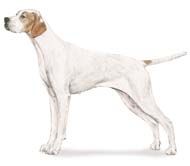
|
Pointer Breed Standard
Sporting Group General Appearance The Pointer is bred primarily for sport afield; he should unmistakably look and act the part. The ideal specimen gives the immediate impression of compact power and agile grace; the head noble, proudly carried; the expression intelligent and alert; the muscular body bespeaking both staying power and dash. Here is an animal whose every movement shows him to be a wide-awake, hard-driving hunting dog possessing stamina, courage, and the desire to go. And in his expression are the loyalty and devotion of a true friend of man. Temperament The Pointer's even temperament and alert good sense make him a congenial companion both in the field and in the home. He should be dignified and should never show timidity toward man or dog. Head The skull of medium width, approximately as wide as the length of the muzzle, resulting in an impression of length rather than width. Slight furrow between the eyes, cheeks cleanly chiseled. There should be a pronounced stop. From this point forward the muzzle is of good length, with the nasal bone so formed that the nose is slightly higher at the tip than the muzzle at the stop. Parallel planes of the skull and muzzle are equally acceptable. The muzzle should be deep without pendulous flews. Jaws ending square and level, should bite evenly or as scissors. Nostrils well developed and wide open. Ears--Set on at eye level. When hanging naturally, they should reach just below the lower jaw, close to the head, with little or no folding. They should be somewhat pointed at the tip--never round--and soft and thin in leather. Eyes--Of ample size, rounded and intense. The eye color should be dark in contrast with the color of the markings, the darker the better. Neck Long, dry, muscular, and slightly arched, springing cleanly from the shoulders. Shoulders Long, thin, and sloping. The top of blades close together. Front Elbows well let down, directly under the withers and truly parallel so as to work just clear of the body. Forelegs straight and with oval bone. Knee joint never to knuckle over. Pasterns of moderate length, perceptibly finer in bone than the leg, and slightly slanting. Chest, deep rather than wide, must not hinder free action of forelegs. The breastbone bold, without being unduly prominent. The ribs well sprung, descending as low as the elbow-point. Back Strong and solid with only a slight rise from croup to top of shoulders. Loin of moderate length, powerful and slightly arched. Croup falling only slightly to base of tail. Tuck-up should be apparent, but not exaggerated. Tail Heavier at the root, tapering to a fine point. Length no greater than to hock. A tail longer than this or docked must be penalized. Carried without curl, and not more than 20 degrees above the line of the back; never carried between the legs. Hindquarters Muscular and powerful with great propelling leverage. Thighs long and well developed. Stifles well bent. The hocks clean; the legs straight as viewed from behind. Decided angulation is the mark of power and endurance. Feet Oval, with long, closely-set, arched toes, well-padded, and deep. Catfoot is a fault. Dewclaws on the forelegs may be removed. Coat Short, dense, smooth with a sheen. Color Liver, lemon, black, orange; either in combination with white or solid-colored. A good Pointer cannot be a bad color. In the darker colors, the nose should be black or brown; in the lighter shades it may be lighter or flesh-colored. Gait Smooth, frictionless, with a powerful hindquarters' drive. The head should be carried high, the nostrils wide, the tail moving from side to side rhythmically with the pace, giving the impression of a well-balanced, strongly-built hunting dog capable of top speed combined with great stamina. Hackney gait must be faulted. Balance and Size Balance and over-all symmetry are more important in the Pointer than size. A smooth, balanced dog is to be more desired than a dog with strongly contrasting good points and faults. Hound or terrier characteristics are most undesirable. Because a sporting dog must have both endurance and power, great variations in size are undesirable, the desirable height and weight being within the following limits: Dogs: Height -- 25-28 inches Weight -- 55-75 pounds Bitches: Height -- 23-26 inches Weight -- 44-65 pounds Approved November 11, 1975 |
|
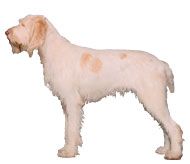
|
Spinone Italiano Breed Standard
Sporting Group General Appearance Muscular dog with powerful bone. Vigorous and robust, his purpose as hardworking gun dog is evident. Naturally sociable, the docile and patient Spinone is resistant to fatigue and is an experienced hunter on any terrain. His hard textured coat is weather resistant. His wiry, dense coat and thick skin enable the Spinone to negotiate underbrush and endure cold water that would severely punish any dog not so naturally armored. He has a remarkable tendency for an extended and fast trotting gait. The Spinone is an excellent retriever by nature. Size, Proportion, Substance: Height: The height at the withers is 23 to 27 inches for males and 22 to 25 inches for females. Weight: In direct proportion to size and structure of dog. Proportion: His build tends to fit into a square. The length of the body, measured from sternum to point of buttocks, is approximately equal to the height at the withers with tolerance of no more than 1 inch in length compared to height. Substance: The Spinone is a solidly built dog, robust with powerful bone. Head: Long. The profile of the Spinone is unique to this breed. Expression is of paramount importance to the breed. It should denote intelligence and gentleness. Skull of oval shape, with sides gently sloping. With occipital protuberance well developed, medial-frontal furrow is very pronounced. Muzzle: Square when viewed from the front. Muzzle length is equal to that of backskull. The planes of the skull and muzzle are diverging, downfaced. Its width measured at its midpoint is a third of its length. Stop is barely perceptible. Bridge of the muzzle is preferably slightly Roman, however, straight is not to be faulted. Lips fitting tightly to the jawline. Convergence of planes of the skull and muzzle or a dish-faced muzzle is to be faulted so severely as to eliminate from further competition. Eyes: Must have a soft sweet expression. Ochre (yellowish brown) in color, darker eyes with darker colored dogs, lighter eyes with lighter colored dogs. Large, well opened, set well apart, the eye is almost round, the lids closely fitting the eye, to protect the eye from gathering debris while the dog is hunting, loose eye lids must be faulted. Which is neither protruding nor deep set. Eye rim clearly visible, color will vary with coat color from flesh colored to brown.Disqualification: Walleye. Nose: Bulbous and spongy in appearance with upper edge rounded. Nostrils are large and well opened. In profile, the nose protrudes past the forward line of the lips. (Pigment is flesh colored in white dogs, darker in white and orange dogs, brown in brown or brown roan dogs.) Disqualification: Any pigment other than described or incomplete pigment of the nose is to be disqualified. Teeth: Jaw is powerful. Teeth are positioned in a scissors or level bite. Disqualification: Overshot or undershot bite. Ears: Practically triangular shape. Set on a level just below the eye, carried low, with little erectile power. The leather is fine, covered with short, thick hair mixed with a longer sparser hair, which becomes thicker along edges. Length, if measured along the head would extend to tip of nose and no more than 1 inch beyond the tip. The forward edge is adherent to the cheek, not folded, but turned outward; the tip of the ear is slightly rounded. Neck, Topline, Body: Neck: Strong, thick, and muscular. Clearly defined from the nape, blending in to the shoulders in a harmonious line. The throat is moderate in skin with a double dewlap. Chest: Broad, deep, well muscled and well rounded; extending at least to the elbow. The ribs are well sprung. The distance from ground to the elbow is equal to 1/2 the height at the withers. Back: The topline consists of two segments. The first slopes slightly downward in a nearly straight line from the withers to the 11th thoracic vertebrae, approximately 6 inches behind the withers. The second rises gradually and continues into a solid and well-arched loin. The underline is solid and should have minimal tuck up. Croup: Well muscled, long. The hipbones fall away from the spinal column at an angle of about 30 degrees, producing a lightly rounded, well filled-out croup. Tail: Follows the line of the croup, thick at the base, carried horizontally or down; flicking from side to side while moving is preferred. The tail should lack fringes. It is docked to a length of 5 1/2 to 8 inches. Tail habitually carried above the level of the back or straight up when working is to be penalized. Forequarters: Shoulders: Powerful and long, withers not too prominent; forming an angle with the upper arm of approximately angle 105. With well-developed muscles, the points of the shoulder blades are not close together. The ideal distance between the shoulder blades is approximately two inches or more. Angulation of shoulder is in balance with angulation in the rear. Forelegs: The forelegs are straight when viewed from the front angle with strong bone and well-developed muscles; elbows set under the withers and close to the body. Pasterns are long, lean and flexible following the vertical line of the forearm. In profile, they are slightly slanted. Feet: Large compact, rounded with well-arched toes, which are close together, covered with short, dense hair, including between the toes. Pads are lean and hard with strong nails curving toward the ground, well pigmented, but never black. Dewclaws may be removed. Hindquarters: Thighs are strong and well muscled, stifles show good function angulation, lower thigh to be well developed and muscled with good breadth. The hock, with proportion of 1/3 the distance from the hip joint to foot being ideal, is strong, lean and perpendicular to the ground. Fault: Cowhocks. Feet: Slightly more oval than the forefoot with the same characteristics. Dewclaws may be removed. Skin: The skin must be very thick, closely fitting the body. The skin is thinner on the head, throat, groin, under the legs and in the folds of the elbows is soft to the touch. Pigmentation is dependent upon the color or markings of the coat. Disqualification: Any black pigmentation. Coat: A Spinone must have a correct coat to be of correct type. The ideal coat length is 1 1/2 to 2 1/2 inches on the body, with a tolerance of 1/2 inch over or under the ideal length. Head, ears, muzzle and front sides of legs and feet are covered by shorter hair. The hair on the backsides of the legs forms a rough brush, but there are never any fringes. The eyes and lips are framed by stiff hair forming eyebrows, mustache and tufted beard, which combine to save fore face from laceration by briar and bush. The coat is dense, stiff and flat or slightly crimped, but not curly, with an absence of undercoat. The Spinone is exhibited in a natural state. The appearance of the Spinone may not be altered. The dog must present the natural appearance of a functional field dog. Dogs with a long, soft or silky coat, the presence of undercoat, or any deviation of the coat is defined in this as well as excessive grooming, i.e., scissoring, clipping, or setting of pattern shall be severely penalized as to eliminate them from further competition. Color: The accepted colors are: Solid white, white and orange; orange roan with or without orange markings; white with brown markings, brown roan with or without brown markings. The most desired color of brown is chestnut brown, "monks habit", however, varying colors of brown are acceptable. Disqualification: Any black in the coat, tan, tri-color, in any combination, or any color other than accepted colors. Gait: The Spinone is first and foremost a functional working gun dog. Its purpose as a versatile hunting dog must be given the utmost consideration. Easy and loose trot geared for endurance. Maximum ground is covered with least amount of effort, which his purpose as a versatile working gun dog demands. Profile of the topline kept throughout the trotting gait, light body roll in mature bitches is characteristic of the breed. While hunting, an extended fast trot with intermittent paces of a gallop allows the Spinone to cover ground quickly and thoroughly. Any characteristics that interfere with the accomplishment of the function of the Spinone shall be considered as a serious fault. Faults: Any departure from the foregoing points constitutes a fault which when judging must be penalized according to its seriousness and extension. Disqualification Wall Eye Any pigment other than described or incomplete pigment of the nose. Overshot or undershot bite. Any black pigmentation. Any black in the coat; tan, tri-color markings in any combination, or any color other than accepted colors. Approved: February 11, 2000 Effective: September 28, 2000 |
|

|
Sussex Spaniel Breed Standard
Sporting Group General Appearance The Sussex Spaniel was among the first ten breeds to be recognized and admitted to the Stud Book when the American Kennel Club was formed in 1884, but it has existed as a distinct breed for much longer. As its name implies, it derives its origin from the county of Sussex, England, and it was used there since the eighteenth century as a field dog. During the late 1800’s the reputation of the Sussex Spaniel as an excellent hunting companion was well known among the estates surrounding Sussex County. Its short legs, massive build, long body, and habit of giving tongue when on scent made the breed ideally suited to penetrating the dense undergrowth and flushing game within range of the gun. Strength, maneuverability, and desire were essential for this purpose. Although it has never gained great popularity in numbers, the Sussex Spaniel continues today essentially unchanged in character and general appearance from those 19th century sporting dogs. The Sussex Spaniel presents a long and low, rectangular and rather massive appearance coupled with free movements and nice tail action. The breed has a somber and serious expression. The rich golden liver color is unique to the breed. Size, Proportion, Substance Size--The height of the Sussex Spaniel as measured at the withers ranges from 13 to 15 inches. Any deviation from these measurements is a minor fault. The weight of the Sussex Spaniel ranges between 35 and 45 pounds. Proportion--The Sussex Spaniel presents a rectangular outline as the breed is longer in body than it is tall. Substance--The Sussex Spaniel is muscular and rather massive. Head Correct head and expression are important features of the breed. Eyes--The eyes are hazel in color, fairly large, soft and languishing, but do not show the haw overmuch. Expression--The Sussex Spaniel has a somber and serious appearance, and its fairly heavy brows produce a frowning expression. Ears--The ears are thick, fairly large, and lobe-shaped and are set moderately low, slightly above the outside corner of the eye. Skull and Muzzle--The skull is moderately long and also wide with an indentation in the middle and with a full stop. The brows are fairly heavy, the occiput is full but not pointed, the whole giving an appearance of heaviness without dullness. The muzzle should be approximately three inches long, broad, and square in profile. The skull as measured from the stop to the occiput is longer than the muzzle. The nostrils are well-developed and liver colored. The lips are somewhat pendulous. Bite-- A scissors bite is preferred. Any deviation from a scissors bite is a minor fault. Neck, Topline, Body Neck--The neck is rather short, strong, and slightly arched, but does not carry the head much above the level of the back. There should not be much throatiness about the skin. Topline and Body-- he whole body is characterized as low and long with a level topline. The chest is round, especially behind the shoulders, and is deep and wide which gives a good girth. The back and loin are long and very muscular both in width and depth. For this development, the back ribs must be deep. Tail-- The tail is docked from 5 to 7 inches and set low. When gaiting the Sussex Spaniel exhibits nice tail action, but does not carry the tail above the level of the back. Forequarters The shoulders are well laid back and muscular. The upper arm should correspond in length and angle of return to the shoulder blade so that the legs are set well under the dog. The forelegs should be very short, strong, and heavily boned. They may show a slight bow. Both straight and slightly bowed constructions are proper and correct. The pasterns are very short and heavily boned. The feet are large and round with short hair between the toes. Hindquarters The hindquarters are full and well-rounded, strong, and heavily boned. They should be parallel with each other and also set wide apart--about as wide as the dog at the shoulders. The hind legs are short from the hock to the ground, heavily boned, and should seem neither shorter than the forelegs nor much bent at the hocks. The hindquarters must correspond in angulation to the forequarters. The hocks should turn neither in nor out. The rear feet are like the front feet. Coat The body coat is abundant, flat or slightly waved, with no tendency to curl. The legs are moderately well-feathered, but clean below the hocks. The ears are furnished with soft, wavy hair. The neck has a well-marked frill in the coat. The tail is thickly covered with moderately long feather. No trimming is acceptable except to shape foot feather, or to remove feather between the pads or between the hock and the feet. The feather between the toes must be left in sufficient length to cover the nails. Color Rich golden liver is the only acceptable color and is a certain sign of the purity of the breed. Dark liver or puce is a major fault. White on the chest is a minor fault. White on any other part of the body is a major fault. Gait The round, deep and wide chest of the Sussex Spaniel coupled with its short legs and long body produce a rolling gait. While its movement is deliberate, the Sussex Spaniel is in no sense clumsy. Gait is powerful and true with perfect coordination between the front and hind legs. The front legs do not paddle, wave, or overlap. The head is held low when gaiting. The breed should be shown on a loose lead so that its natural gait is evident. Temperament Despite its somber and serious expression, the breed is friendly and has a cheerful and tractable disposition. Faults The standard ranks features of the breed into three categories. The most important features of the breed are color and general appearance. The features of secondary importance are the head, ears, back and back ribs, legs, and feet. The features of lesser importance are the eyes, nose, neck, chest and shoulders, tail, and coat. Faults also fall into three categories. Major faults are color that is too light or too dark, white on any part of the body other than the chest, and a curled coat. Serious faults are a narrow head, weak muzzle, the presence of a topknot, and a general appearance that is sour and crouching. Minor faults are light eyes, white on chest, the deviation from proper height ranges, lightness of bone, shortness of body or a body that is flat-sided, and a bite other than scissors. There are no disqualifications in the Sussex Spaniel standard. Approved April 7, 1992 Effective May 27, 1992 |
|

|
Vizsla Breed Standard
Sporting Group Sporting Group; AKC recognized in 1960. Average size: 21 to 24 inches tall at the shoulder. Hunting dog, family companion. |
|
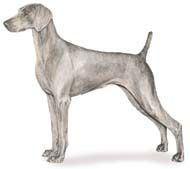
|
Weimaraner Breed Standard
Sporting Group AKC recognized in 1943. Average size: 23 to 27 inches tall at the shoulder. Hunting dog, family companion. |
|
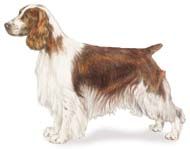
|
Welsh Springer Spaniel Breed Standard
Sporting Group General Appearance The Welsh Springer Spaniel is a dog of distinct variety and ancient origin, who derives his name from his hunting style and not his relationship to other breeds. He is an attractive dog of handy size, exhibiting substance without coarseness. He is compact, not leggy, obviously built for hard work and endurance. The Welsh Springer Spaniel gives the impression of length due to obliquely angled forequarters and well developed hindquarters. Being a hunting dog, he should be shown in hard muscled working condition. His coat should not be so excessive as to hinder his work as an active flushing spaniel, but should be thick enough to protect him from heavy cover and weather. Size, Proportion, Substance A dog is ideally 18-19 inches in height at the withers and a bitch is 17-18 inches at the withers. Any animal above or below the ideal to be proportionately penalized. Weight should be in proportion to height and overall balance. Length of body from the withers to the base of the tail is very slightly greater than the distance from the withers to the ground. This body length may be the same as the height but never shorter, thus preserving the rectangular silhouette of the Welsh Springer Spaniel. Head The Welsh Springer Spaniel head is unique and should in no way approximate that of other spaniel breeds. Its overall balance is of primary importance. Head is in proportion to body, never so broad as to appear coarse nor so narrow as to appear racy. The skull is of medium length, slightly domed, with a clearly defined stop. It is well chiseled below the eyes. The top plane of the skull is very slightly divergent from that of the muzzle, but with no tendency toward a down-faced appearance. A short chubby head is most objectionable. Eyes should be oval in shape, dark to medium brown in color with a soft expression. Preference is for a darker eye though lighter shades of brown are acceptable. Yellow or mean-looking eyes are to be heavily penalized. Medium in size, they are neither prominent, nor sunken, nor do they show haw. Eye rims are tight and dark pigmentation is preferred. Ears are set on approximately at eye level and hang close to the cheeks. Comparatively small, the leather does not reach to the nose. Gradually narrowing toward the tip, they are shaped somewhat like a vine leaf and are lightly feathered. The length of the muzzle is approximately equal to, but never longer than that of the skull. It is straight, fairly square, and free from excessive flew. Nostrils are well developed and black or any shade of brown in color. A pink nose is to be severely penalized. A scissors bite is preferred. An undershot jaw is to be severely penalized. Neck, Topline, Body The neck is long and slightly arched, clean in throat, and set into long, sloping shoulders. Topline is level. The loin is slightly arched, muscular, and close-coupled. The croup is very slightly rounded, never steep nor falling off. The topline in combination with proper angulation fore and aft presents a silhouette that appears rectangular. The chest is well developed and muscular with a prominent forechest, the ribs well sprung and the brisket reaching to the elbows. The tail is an extension of the topline. Carriage is nearly horizontal or slightly elevated when the dog is excited. The tail is generally docked and displays a lively action. Forequarters The shoulder blade and upper arm are approximately equal in length. The upper arm is set well back, joining the shoulder blade with sufficient angulation to place the elbow beneath the highest point of the shoulder blade when standing. The forearms are of medium length, straight and moderately feathered. The legs are well boned but not to the extent of coarseness. The Welsh Springer Spaniel’s elbows should be close to the body and its pasterns short and slightly sloping. Height to the elbows is approximately equal to the distance from the elbows to the top of the shoulder blades. Dewclaws are generally removed. Feet should be round, tight and well arched with thick pads. Hindquarters The hindquarters must be strong, muscular, and well boned, but not coarse. When viewed in profile the thighs should be wide and the second thighs well developed. The angulation of the pelvis and femur corresponds to that of the shoulder and upper arm. Bend of stifle is moderate. The bones from the hocks to the pads are short with a well angulated hock joint. When viewed from the side or rear they are perpendicular to the ground. Rear dewclaws are removed. Feet as in front. Coat The coat is naturally straight flat and soft to the touch, never wiry or wavy. It is sufficiently dense to be waterproof, thornproof, and weatherproof. The back of the forelegs, the hind legs above the hocks, chest and underside of the body are moderately feathered. The ears and tail are lightly feathered. Coat so excessive as to be a hindrance in the field is to be discouraged. Obvious barbering is to be avoided as well. Color The color is rich red and white only. Any pattern is acceptable and any white area may be flecked with red ticking. Gait The Welsh Springer moves with a smooth, powerful, ground covering action that displays drive from the rear. Viewed from the side, he exhibits a strong forward stride with a reach that does not waste energy. When viewed from the front, the legs should appear to move forward in an effortless manner with no tendency for the feet to cross over or interfere with each other. Viewed from the rear, the hocks should follow on a line with the forelegs, neither too widely nor too closely spaced. As the speed increases the feet tend to converge towards a center line. Temperament The Welsh Springer Spaniel is an active dog displaying a loyal and affectionate disposition. Although reserved with strangers, he is not timid, shy nor unfriendly. To this day he remains a devoted family member and hunting companion. Approved June 13, 1989 Effective August 1, 1989 |
|
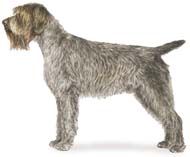
|
Wirehaired Pointing Griffon Breed Standard
Sporting Group General Appearance Medium sized, with a noble, square-shaped head, strong of limb, bred to cover all terrain encountered by the walking hunter. Movement showing an easy catlike gracefulness. Excels equally as a pointer in the field, or a retriever in the water. Coat is hard and coarse, never curly or woolly, with a thick undercoat of fine hair, giving an unkempt appearance. His easy trainability, devotion to family, and friendly temperament endear him to all. The nickname of "supreme gundog" is well earned. Size, Proportion, Substance Size--22 to 24 inches for males, 20 to 22 inches for females. Correct size is important. Oversize to be severely penalized. Proportion--Slightly longer than tall, in a ratio of 10 to 9. Height from withers to ground; length from point of shoulder to point of buttocks. The Griffon must not evolve towards a square conformation. Substance medium, reflecting his work as an all-terrain hunting dog. Head The head is to be in proportion to the overall dog. The skull is of medium width with equal length from nose to stop and from stop to occiput. The skull is slightly rounded on top, but from the side the muzzle and head are square. The stop and occiput are only slightly pronounced. The required abundant mustache and eyebrows contribute to the friendly expression. The eyes are large and well open, more rounded than elliptical. They have an alert, friendly, and intelligent expression. Eye color ranges in all shades of yellow and brown. Haws should not show nor should there be protruding eyes. The ears should be of medium size, lying flat and close to the head, set high, at the height of the eye line. Nose--Well open nostrils are essential. Nose color is always brown. Any other color is a disqualification. Bite scissors. Overshot or undershot bite is a serious fault. Neck, Topline, Body Neck-- rather long, slightly arched, no dewlap. Topline-- The back is strong and firm, descending in a gentle slope from the slightly higher withers to the base of the tail. Body-Chest-- The chest must descend to the level of the elbow, with a moderate spring of rib. The chest must neither be too wide nor too narrow, but of medium width to allow freedom of movement. The loin is strong and well developed, being of medium length. The croup and rump are stoutly made with adequate length to favor speed. The tail extends from the back in a continuation of the topline. It may be carried straight or raised slightly. It is docked by one-third to one-half length. Forequarters Shoulders are long, with good angulation, and well laid back. The forelegs are straight and vertical from the front and set well under the shoulder from the side. Pasterns are slightly sloping. Dewclaws should be removed. Feet are round, firm, with tightly closed webbed toes. Pads are thick. Hindquarters The thighs are long and well muscled. Angulation in balance with the front. The legs are vertical with the hocks turning neither in nor out. The stifle and hock joints are strong and well angulated. Feet as in front. Coat The coat is one of the distinguishing features of the breed. It is a double coat. The outer coat is medium length, straight and wiry, never curly or woolly. The harsh texture provides protection in rough cover. The obligatory undercoat consists of a fine, thick down, which provides insulation as well as water resistance. The undercoat is more or less abundant, depending upon the season, climate, and hormone cycle of the dog. It is usually lighter in color. The head is furnished with a prominent mustache and eyebrows. These required features are extensions of the undercoat, which gives the Griffon a somewhat untidy appearance. The hair covering the ears is fairly short and soft, mixed with longer harsh hair from the coat. The overall feel is much less wiry than the body. The legs, both front and rear, are covered with denser, shorter, and less coarse hair. The coat on the tail is the same as the body; any type of plume is prohibited. The breed should be exhibited in full body coat, not stripped short in pattern. Trimming and stripping are only allowed around the ears, top of head, cheeks and feet. Color Preferably steel gray with brown markings, frequently chestnut brown, or roan, white and brown; white and orange also acceptable. A uniformly brown coat, all white coat, or white and orange are less desirable. A black coat disqualifies. Gait Although close working, the Griffon should cover ground in an efficient, tireless manner. He is a medium-speed dog with perfect coordination between front and rear legs. At a trot, both front and rear legs tend to converge toward the center line of gravity. He shows good extension both front and rear. Viewed from the side, the topline is firm and parallel to the line of motion. A smooth, powerful ground-covering ability can be seen. Temperament The Griffon has a quick and intelligent mind and is easily trained. He is outgoing, shows a tremendous willingness to please and is trustworthy. He makes an excellent family dog as well as a meticulous hunting companion. Disqualifications Nose any color other than brown. Black coat. Approved October 8, 1991 Effective November 28, 1991 |

